PAC PAC-CNC Network controller with low range proximity reader User Manual 15162
PAC International Limited Network controller with low range proximity reader 15162
PAC >
Manual

Installation Guide
January 2003 15162 Ver 2.8 DRAFT E
PAC Portico Portico, 1 Lower Ragsdale Drive, Building 3, Suite 800, Monterey, California 93940 USA
www.PACPortico.com
This document is correct at the time of going to press. However, as part of our ongoing product
enhancement program we reserve the right to make changes to the product and/or literature at any time
without prior notice.
Central Network Controller
Copyright and Protective Notices
1. The copyright of this document and the associated drawings is the property of PAC Portico (Blick
USA, Inc.), and is issued on condition that it is not copied, reprinted or reproduced, nor its
contents disclosed, either wholly or in part, without the consent in writing of, or in accordance
with the conditions of a contract with of PAC Portico (Blick USA, Inc.).
2. The publication of information in this document does not imply freedom from patent or other
protective rights of PAC Portico (Blick USA, Inc.), or others.
3. Performance figures and data quoted in this document are typical, and must be specifically
confirmed by of PAC Portico (Blick USA, Inc.) before they become applicable to any tender, order
or contract.
Training and Technical Support
Training courses covering the installation and use of all PAC Portico products are regularly held at
Blick USA in Monterey California.
It is strongly recommended that any persons installing or programming PAC Portico
products attend a suitable training course beforehand.
Technical Support for all PAC Portico products is available during normal office hours. This
service is provided primarily for the use of trained installers. End users of PAC Portico products
should first contact their installation or maintenance company before contacting PAC Portico.
Literature. If you have any comments on this or any other PAC Portico literature, then you can
either write to ‘Technical Writing’ at the address below or you can email us at: manuals@PAC
Portico.com
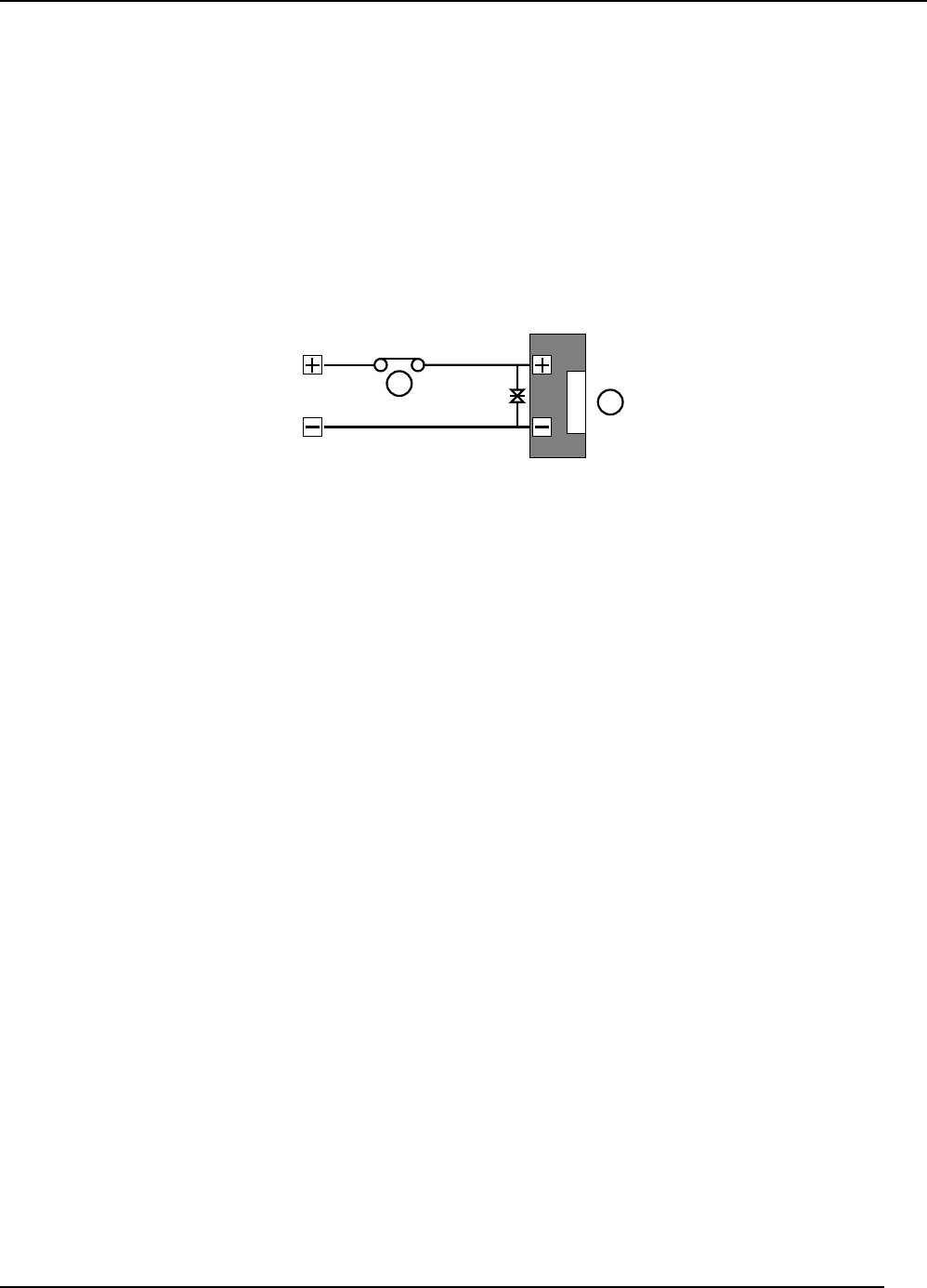
15162 Ver 2.8 DRAFT E Central Network Controller Installation Guide
Page 2 © 2002 Blick USA, Inc.
IMPORTANT:
When installing the PAC Portico equipment the following should be noted:
HEALTH AND SAFETY
Installation must wired in accordance with National Wiring Regulations (BS7671, IEE
National Wiring Regulations in the UK). Failure to do so can result in injury or death by
electric shock.
It must also comply with any local Fire, Health and Safety regulations. A secured door that
may be part of an escape route from an area must be installed with:
•A Fail-Safe lock (A). So that the door will be released if the power fails. Ideally a magnetic
lock should be used as these are less likely to jam or seize.
•A normally-closed Break-Glass or Manual Pull (B) in the lock supply wiring. So that in an
emergency the fail-safe lock can be immediately depowered.
B
A
The controller must be connected to Earth Ground. Isolate the controller supply before
working on the controller.
CABLING
The cabling used in the PAC Portico access control systems (six wire bus, reader cables, etc.) are
not prone to electrical interference. However, you should avoid routing cable close to heavy load
switching cables and equipment. If this is unavoidable then cross the cable at right angles every 1-
2m (3 to 6 ft) to reduce the interference.
RFID Devices
As similar RFID technology is now widely used in a number of other industries, for example
automotive immobilisers, it is possible that interaction between your access control credential and
other devices may cause one or the other to function incorrectly. Should you suspect that you have
experienced such a problem the solution is to separate your access control credential from other
RFID devices.
FCC Notice
This device complies with part 15 of the FCC rules. Operation is subject to the following two
conditions (1) this device may not cause harmful interference, and (2) this device must accept any
interference received, including interference that may cause undesired operation.
KeyPAC CNC FCC ID OQL-PAC-CNC
PAC CNC FCC ID OQL-P-CNC
Changes or modifications not expressly approved by the party responsible for compliance could
void the user's authority to operate the equipment.
Note
This equipment has been tested and found to comply with the limits for a Class A digital
device, pursuant to part 15 of the FCC Rules. These limits are designed to provide
reasonable protection against harmful interference when the equipment is operated in a
commercial environment. This equipment generates, uses, and can radiate radio frequency
energy and, if not installed and used in accordance with the instruction manual, may cause
harmful interference to radio communications. Operation of this equipment in a residential
area is likely to cause harmful interference in which case the user will be required to correct
the interference at his own expense.

Central Network Controller Installation Guide 15162 Ver 2.8 DRAFT E
© 2002 Blick USA, Inc. Page 3
Table of Contents
HEALTH AND SAFETY............................................................................................................. 2
CABLING ................................................................................................................................... 2
RFID Devices............................................................................................................................. 2
FCC Notice ................................................................................................................................ 2
Table of Figures........................................................................................................................... 4
Abbreviations Used in this Document ...................................................................................... 5
1. About this Document .............................................................................................................. 6
1.1 MKI and MKII CNC Hardware ............................................................................................. 6
1.2 Single-Site and Multi-Site .................................................................................................... 6
1.3 Administration Systems ....................................................................................................... 6
1.4 Other Documents ................................................................................................................ 7
1.5 Margin Notes ....................................................................................................................... 7
1.6 Definitions ............................................................................................................................ 7
1.7 CNC Models ........................................................................................................................ 7
2. Description ............................................................................................................................... 8
2.1 Power Supply ...................................................................................................................... 8
2.2 Internal Features ................................................................................................................. 9
2.3 External Connections ........................................................................................................11
2.4 Description......................................................................................................................... 12
2.5 Installation.......................................................................................................................... 12
2.6 Conversion Cables ............................................................................................................ 13
2.7 Using More than One CNC ............................................................................................... 13
3. Features.................................................................................................................................. 15
3.1 Dial-Up............................................................................................................................... 15
3.2 Dial-Back ........................................................................................................................... 15
3.3 Communications Protection .............................................................................................. 15
3.4 Site Types/Numbers ..........................................................................................................15
3.5 Front Panel Display ........................................................................................................... 16
4. Installation.............................................................................................................................. 19
4.1 Power Supply .................................................................................................................... 19
4.2 Description......................................................................................................................... 19
4.3 Installation.......................................................................................................................... 19
4.4 Conversion Cables ............................................................................................................ 20
4.5 Host PC ............................................................................................................................. 20
4.6 External Reader................................................................................................................. 22
4.7 Description......................................................................................................................... 22
4.8 Installation.......................................................................................................................... 22
4.9 Conversion Cables ............................................................................................................ 23
4.10 Six Wire Bus .................................................................................................................... 23
5. Serial Communications......................................................................................................... 26
5.1 Direct Connection .............................................................................................................. 26
5.2 Dial-Up Communications................................................................................................... 27
6. Specification .......................................................................................................................... 30
6.1 Dimensions........................................................................................................................ 30
6.2 Power Requirements ......................................................................................................... 30
6.3 Fuses ................................................................................................................................. 30
6.4 Cables Supplied ................................................................................................................ 30
6.5 Description......................................................................................................................... 30

15162 Ver 2.8 DRAFT E Central Network Controller Installation Guide
Page 4 © 2002 Blick USA, Inc.
6.6 Installation.......................................................................................................................... 30
6.7 Conversion Cables ............................................................................................................ 31
6.8 Description......................................................................................................................... 33
6.9 Installation.......................................................................................................................... 33
6.10 Conversion Cables ..........................................................................................................34
6.11 Description....................................................................................................................... 34
6.12 Installation........................................................................................................................ 34
6.13 Conversion Cables ..........................................................................................................35
6.14 Door Controller Software ................................................................................................. 36
6.15 Mean Time Between Failures.......................................................................................... 36
7. Appendix A - Full Download................................................................................................. 37
7.1 Description......................................................................................................................... 37
7.2 Download Procedure .........................................................................................................37
8. Appendix B - Non-PAC Portico Communication Devices ................................................. 38
8.1 Dial-Up Modems................................................................................................................ 38
8.2 Black Box Non-Powered Short Haul Modem - SHM-NPR ................................................ 38
8.3 Black Box Line Driver - LD-120MP.................................................................................... 39
8.4 pIPer Serial Ethernet Units ................................................................................................39
9. Appendix C - 21512 CNC MKI to MKII Upgrade Kit ............................................................ 40
9.1 Description......................................................................................................................... 40
9.2 Installation.......................................................................................................................... 40
9.3 Conversion Cables ............................................................................................................ 41
10. Appendix D - Cable Descriptions....................................................................................... 42
10.1 Power Supply .................................................................................................................. 42
10.2 Host PC ........................................................................................................................... 42
10.3 Six Wire Bus .................................................................................................................... 43
10.4 RS-232 Ports ................................................................................................................... 43
10.5 External Reader............................................................................................................... 45
10.6 LD-120MP Line Drivers ................................................................................................... 46
11. Appendix E - COS-4/8 Data Switches................................................................................ 47
Table of Figures
Figure 1 CNC Front Panel (with built-in PAC Portico reader) 8
Figure 2 CNC Rear Panel 8
Figure 3 Power Supply Unit - Front View 8
Figure 4 Power Supply Unit - Rear View 9
Figure 5 CNC - Internal Components 9
Figure 6 Possible Six Wire Bus Wiring Configurations 24
Figure 7 CNC Using Dial-Back 28
Figure 8 CNC to Door Controller Wiring 43
Figure 9 Remote Site Master to Slave Wiring 43

Central Network Controller Installation Guide 15162 Ver 2.8 DRAFT E
© 2002 Blick USA, Inc. Page 5
Abbreviations Used in this Document
CLK Clock
CNC Central Network Controller
COM Common
COS Code Operated Switch
CTS Clear To Send
D/C Door Controller
DOS Disc Operating System
GND Ground
LED Light Emitting Diode
MS-DOS Microsoft Disc Operating System
PC Personnel Computer
PIN Personal Identity Number
PSTN Postal Standard Telephone Network
RX Receive
SIG Signal
TX Transmit
VCA Valid Code Accepted

15162 Ver 2.8 DRAFT E Central Network Controller Installation Guide
Page 6 © 2002 Blick USA, Inc.
1. About this Document
This document describes the installation of a PAC Portico Central Network Controller (CNC) and the
various communication options available. The CNC allows PAC Portico Door Controllers to be
administered from a central Personal Computer (PC). The central PC will be running PAC Portico for
Windows or PAC Portico Prism administration software.
1.1 MKI and MKII CNC Hardware
This document is written based on the MKII CNC hardware which has a 9-way male D-type RS-232 port
connectors on the rear of the case, as opposed to the MKI CNC which has 25-way female D-type RS-232
port connectors.
An upgrade kit (part number 21512) is available that allows installations which use the MKI CNC to be
converted - this includes the new CNC itself and adapter cables. Use of this upgrade kit is described fully
in Appendix C - 21512 CNC MKI to MKII Upgrade Kit.
The major new features in the MKII CNC are:
• Overall controller download speed improvement of 3-5 times.
• Improved management of ‘updates’ - i.e. changes made to administration system database.
• Support for external Wiegand readers. It will work with all current Wiegand formats.
• Support for external Magstripe readers. This is for “true” Magstripe readers and does not work with
Magstripe readers with a PAC Portico output.
• Dialing of dial-up sites at a programmable interval of between 10 minutes and 24 hours.
• Displays which sites are on-line, even if no updates are waiting to be sent.
• 9-way D-type RS-232 connectors used on rear for compatibility with standard PC-to-modem cables.
• Improved reading range on front panel PAC Portico reader.
• Option switches now accessible through hole in underside of unit, eliminating need to remove the
cover.
Two types of front panel reader are available with the MKII CNC:
• PAC Portico PAC reader for use with systems using PAC ID devices.
• PAC Portico KeyPAC reader for use with systems using KeyPAC ID devices.
Note
CNCs with the KeyPAC front panel reader are identified by having a blue key on the front panel.
1.2 Single-Site and Multi-Site
Previously the MKI CNC was supplied in two versions - single-site and multi-site. The single-site CNC
allowed up to 32 door controllers to be connected locally on the PAC Portico six wire bus only. The multi-
site CNC allows up to 128 sites, including the local six wire bus, to be controlled. The extra 127 sites are
connected using serial RS-232 communications.
The MKI Single Site CNC was discontinued with the release of PAC Portico for Windows Version 3.0.
The MKII CNC is supplied in a multi-site version only. When upgrading from a single site system, change
the CNC and the settings in PAC Portico for Windows to reflect the change.
1.3 Administration Systems
The administration systems available with PAC Portico Access Control Systems are described in the
documentation supplied with the door controller. PC-based administration systems run administration
software (e.g. PAC Portico for Windows or PAC Portico Prism). The administration software is provided
on a CD that includes appropriate documentation and help files.

Central Network Controller Installation Guide 15162 Ver 2.8 DRAFT E
© 2002 Blick USA, Inc. Page 7
1.4 Other Documents
This document should be used in conjunction with the following other documents:
1.4.1 Door Controllers
15113 PAC Portico 2100/1100 Installation Guide
15263 PAC Portico 2200/1200 Series Controllers Installation Guide
These documents describe the installation of the PAC Portico controllers which can be connected to the
CNC. They include, where appropriate, connection to readers, locks and configuration information.
Information on connecting the door controllers to the CNC, via the six wire bus or RS-232 is included
within this document, see Sections 4 and 5.
Note
Throughout this document reference is made to the door controller. Unless explicitly stated
otherwise, this includes PAC Portico 1100, 2100, 1200 and 2200 Door Controllers.
1.4.2 Administration Software
The documentation supplied depends on the administration software used on the application. All
administration software documentation is now supplied on CD. Context-sensitive help is also supplied.
1.5 Margin Notes
Throughout the manual wherever there are specific items referring to particular administration systems or
particular models of door controller, a margin note will highlight the fact. For example:
PAC
Portico
1200
Applies only to the PAC Portico 1200 2-door controller.
PAC
Portico
for
Windows
Applies only to PAC Portico for Windows.
PAC
Portico
Prism
Applies only to PAC Portico Prism.
MKII
Only
Applies only to the MKII CNC.
1.6 Definitions
A full glossary of all terms particular to PAC Portico Access Control Systems is included in the
administration documentation supplied on CD.
1.7 CNC Models
The CNC comes in two models with the only difference being the built-in key reader technology (PAC or
KeyPAC) for administration of ID devices.
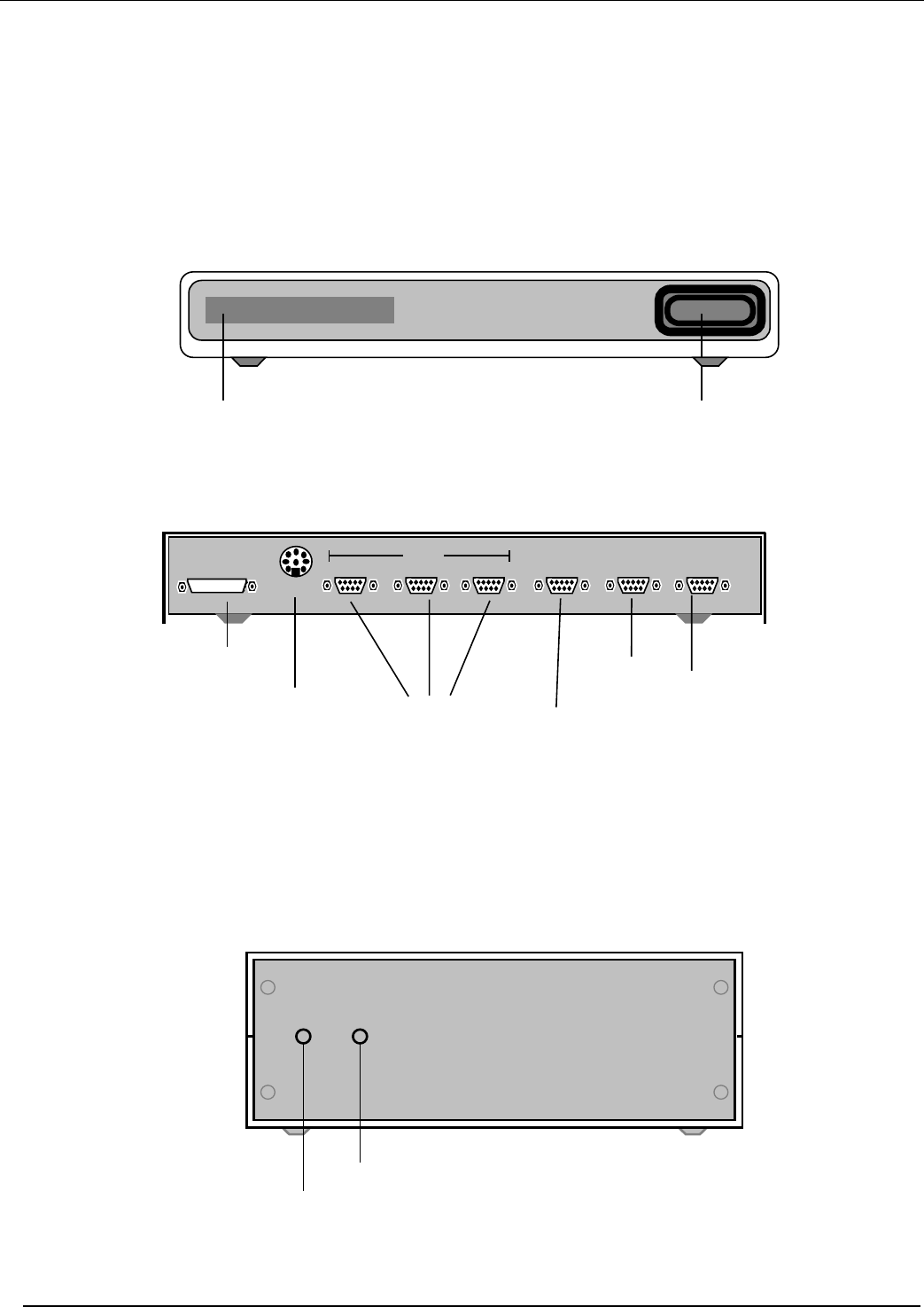
15162 Ver 2.8 DRAFT E Central Network Controller Installation Guide
Page 8 © 2002 Blick USA, Inc.
2. Description
The CNC is a flat, steel cased unit ideally suited to being mounted between a PC system unit and the PC
monitor.
The front of the CNC has a 16-character display where system messages are displayed and a key reader
for key administration and alarm acceptance. The rear of the controller has six 9-way D-type connectors -
used for power, six wire bus, host PC and three RS-232 serial ports.
The rear of the CNC also includes an 8-way DIN connector for connection of an external PAC, KeyPAC,
Magstripe and/or Wiegand/Smartcard reader.
NETWORK CONTROLLER
**MONITORING**
Key ReaderDisplay Screen
Figure 1 CNC Front Panel (with built-in PAC Portico reader)
Note
A blue key on the front panel indicates that the built-in reader is a KeyPAC reader.
Expansion Port
External Reader
Connector
(Blanked)
PORT 3
RS 232
PORT 2 PORT 1 HOST PC SIX WIRE BUS
POWER
Six-Wire Bus
Connect to PC
Serial Ports
Connect to Power Supply
SUPPLY
EXTERNAL
READER
EXPANSION PORT
Figure 2 CNC Rear Panel
2.1 Power Supply
Power is provided to the CNC by a separate power supply unit, supplied with every CNC (not included in
the MKI to MKII Upgrade Kit). Three versions are available:
1. Boxed version with space for backup batteries (shown below).
2. Boxed version with space for backup batteries (not used with administration software).
.
Green - Power On Lamp
Red - No Battery Lamp
Figure 3 Power Supply Unit - Front View
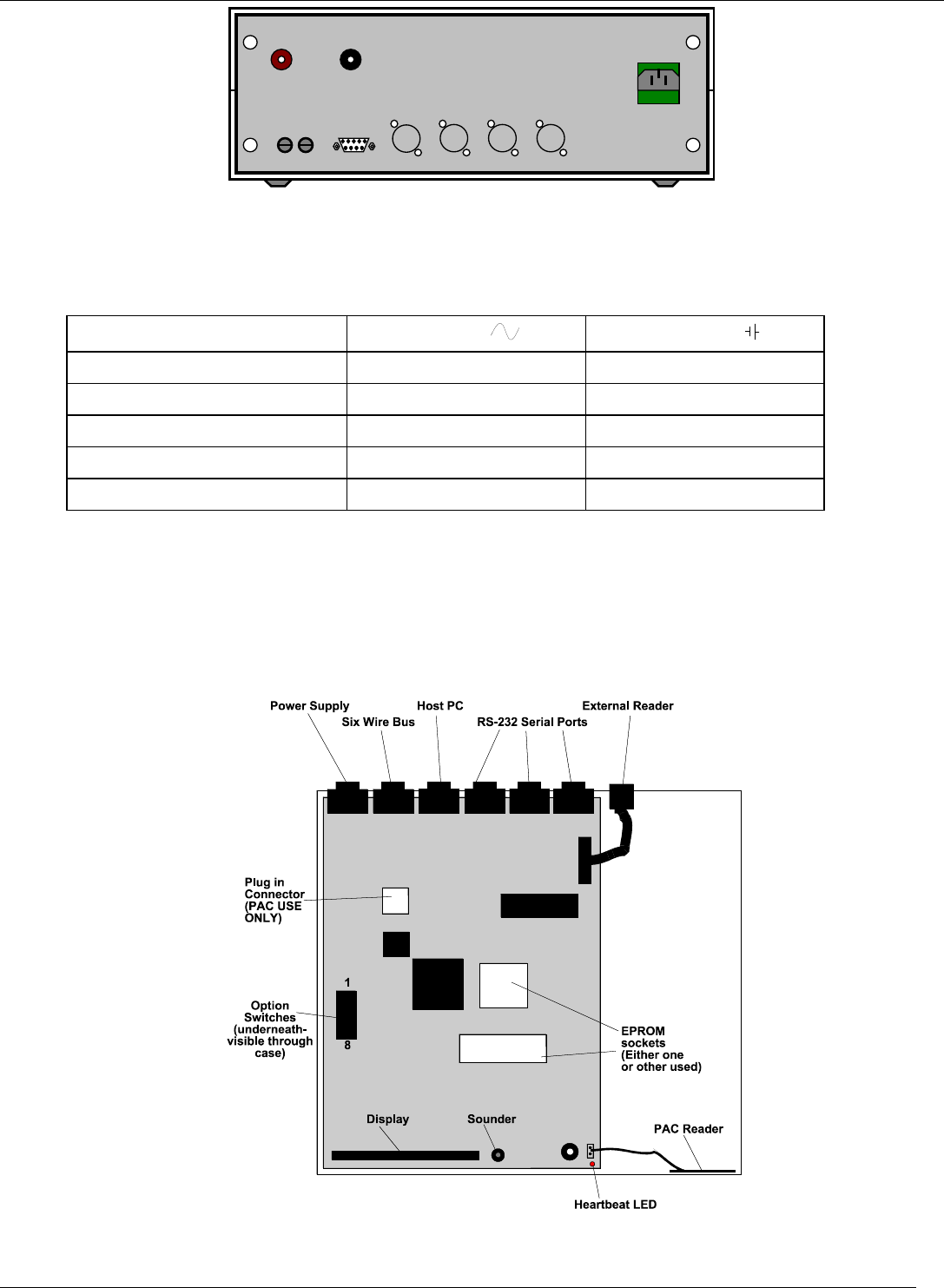
Central Network Controller Installation Guide 15162 Ver 2.8 DRAFT E
© 2002 Blick USA, Inc. Page 9
+-BATTERY
12V
3A 3A
BATTERY NETWORK
CONTROLLER
MAINS I/P
T250mA
RL1 RL3 RL4RL2
Ext Int
Figure 4 Power Supply Unit - Rear View
2.1.1 LED Operation
The two LEDs provided on the CNC indicate the current status of the mains and battery supply. The
following table indicates the status of each LED under different conditions.
Power Red LED ( )Green LED ( )
Mains, with battery ON ON
Mains, with no battery ON ON
No mains, with battery OFF ON
No mains, battery low (<10.5V) OFF OFF
No mains, no battery OFF OFF
Note
The battery can be low (<10.5V) but it will still operate the CNC as there has been some leeway
allowed between the battery low indication and the CNC failing. This allows sufficient time for the
battery to be changed.
2.2 Internal Features
You should not need to remove the lid of the CNC unless upgrading the software. The electronics are
contained on a single circuit board.
Figure 5 CNC - Internal Components

15162 Ver 2.8 DRAFT E Central Network Controller Installation Guide
Page 10 © 2002 Blick USA, Inc.
2.2.1 Switches
MKII
Only
There is a set of switches on the main circuit board, located on the underside and accessible through a
hole in the case, without removing the cover. On the MKI CNC it was necessary to remove the cover of
the CNC to access these switches.
These switches are used for feature selection. Switch 1 is located nearest the rear of the CNC, switch 8
nearest the front.
These switches are ON when switched towards the left hand, outer edge of the CNC (closest to
switches).
All these switches should be OFF, except for:
Switch 4 - External Reader:
• Magstripe Reader: This switch should be OFF, towards the center of the CNC. This is the
default setting.
• PAC, KeyPAC , or Wiegand: This switch should be ON, towards the edge of the CNC.
Switch 5 - Internal Sounder:
When switched ON this switch silences the internal sounder - including when alarms are received,
and the PC is off-line.
Switch 7 - Host PC to CNC Baud Rate:
• PAC Portico for Windows (9600): This switch should always be OFF, towards the center of
the CNC - this is the default setting.
• PAC Portico Prism (9600): This switch should always be OFF, towards the center of the CNC -
this is the default setting.
2.2.2 Heartbeat LED
The CNC features a red LED, visible through the front panel bezel, which pulses to indicate the CNC is
powered and operating.
MKII
Only
The LED will flash more rapidly to indicate a ‘bad read’ when a Wiegand and/or Magstripe reader is
connected to the external reader port on the rear of the CNC
2.2.3 Display
A 16-character vacuum-fluorescent display is used to display a range of messages - including
communications to door controllers and the host PC, alarm events when the PC is off-line, and other
system messages.
2.2.4 Sounder
When an alarm event is received by the CNC and the host PC is off-line, the CNC will bleep to annunciate
the alarm. The sounder may be turned off by turning switch 5 ON (not recommended).
2.2.5 Reader
Located behind the front panel bezel, towards the right-hand side is a built-in proximity reader. This may
be a PAC reader or a KeyPAC reader (the KeyPAC reader is indicated by a blue key symbol on the front
panel). This reader is used for a variety of purposes - including operators logging into the PC software,
key administration and acceptance of alarms.
MKII
Only
If any non-PAC Portico ID devices are in use, a Wiegand or Magstripe reader may be connected to the
external reader connector on the rear panel, see Section 2.3.5.

Central Network Controller Installation Guide 15162 Ver 2.8 DRAFT E
© 2002 Blick USA, Inc. Page 11
2.3 External Connections
The rear panel of the CNC includes six 9-way D-type connectors and one 8-way DIN connector.
The function of each of these connectors is described briefly, starting from the right (as viewed from the
rear of the CNC). More detail is provided on the exact connections available in Section 4.
2.3.1 Power Supply
A 9-way male D-type connector is used to connect the CNC to the Power Supply Unit (PSU). This
provides all the required voltages to the CNC, and also the feeds to the relays built into the PSU itself.
2.3.2 Six Wire Bus
This port is a 9-way female D-type connector to which up to 32 door controllers may be connected. The
total distance can be up to 3000ft/1000m with a maximum of 1500ft/500m between door controllers.
2.3.3 Host PC
The host computer connects to this port, using one of the leads supplied, and via a COM: serial port on
the PC.
This port is a 9-way D-type male connector (25-way male on MKI CNC).
2.3.4 RS-232 Ports 1-3
A wide variety of devices may be connected to these ports, for communication to door controllers. These
devices include PSTN or LAN/WAN modems, radio or microwave communication modules, fiber optic or
wire line drivers, etc. - generally any communications device that features an RS-232 interface.
Again these three ports are 9-way D-type male connectors (25-way male on MKI CNC).
These three ports are identical in function - each may be configured independently through the
administration software to indicate the communications method in use.
2.3.5 External Reader
MKII
Only
This connector, an 8-way female DIN connector, allows the connection of an external reader which can
be used in addition to or in place of the built-in proximity reader for keyholder administration purposes,
logging into the administration software and acceptance of alarms.
Note
The external reader can be PAC, KeyPAC, Magstripe and/or Wiegand reader. These different types
of reader can be connected directly to this port and no interface unit is required. .
It is possible to use multiple reading technologies on the same CNC (e.g. PAC and KeyPAC PAC and
Wiegand, PAC and Magstripe) by using a combination of PC interface kit, built-in reader and external
reader. No configuration is required to use the external reader connector.
The CNC supports the following formats of Wiegand/Magstripe compatible devices:
2.3.5.1 Wiegand
• Sensor Engineering 26-bit (2601)
• Casi-Rusco 28 bit
• Standard 34 bit
• Shorrock 56 bit
• Universal Wiegand
Note
The universal Wiegand option allows any card to produce a token code. Any card greater than 16
bits will produce a token code.

15162 Ver 2.8 DRAFT E Central Network Controller Installation Guide
Page 12 © 2002 Blick USA, Inc.
2.3.5.2 Magstripe
• Paxton/MR Sensors 7 digit
• Paxton/MR Sensors 9 digit
• Paxton/MR Sensors 11 digit
• Default Bank Format
Note
If an external Magstripe reader is being used, the output from this reader must be in Magstripe
format or PAC format, even if the Magstripe readers on the system output the ID in PAC format.
A 6.6ft/2m flying lead is supplied with the CNC. One end is terminated in an 8-way male DIN plug, the
other end is flying leads. See Appendix C - 21512 CNC MKI to MKII Upgrade Kit
2.4 Description
This kit allows you to upgrade an existing CNC-based installation to use the improved features and
performance of the new CNC, with the minimum of effort and time involved in performing the upgrade.
2.4.1 Contents of the Kit
The kit consists of a MKII CNC (the power supply is not supplied with this kit - the existing power supply
should be used) and four cables. These cables should be used to connect the cables that currently
connect to the host PC and RS-232 ports of the existing MKI CNC to the new MKII CNC.
Note
Do not attempt to use these cables to connect the MKII CNC directly to the host PC, modem, or
other RS-232 device - they will not work. They are ‘conversion’ cables.
2.5 Installation
1. Ensure the PC administration software is running and the CNC display is showing:
** MONITORING **
If any updates are displayed for sites, you should make sure they are sent to the door controllers on
those sites first - for sites that communicate via a dial-up modem, you may need to ‘force dial’ the site
first.
2. Make sure that all the connectors currently plugged into the rear of the CNC are labelled and easily
identified.
3. Make sure the On-Line Transaction display is visible and transactions are being displayed.
4. Disconnect the connectors from RS-232 ports 1 to 3 and the six wire bus on the rear of the CNC.
5. When no further transactions are being displayed by the PC administration software, log in to the PC
administration software using the supervisor key/card.
6. Disconnect the host PC and power supply connectors from the rear of the CNC.
7. Ensure the switches on the underside of the MKII CNC are correctly set, see Section 2.2.1. Particular
attention should be made to switch 7 - Host PC to CNC Baud Rate which is dependent on the
administration system being used.
8. Replace the MKI CNC with the MKII CNC.
9. Connect the cable from the power supply to the power supply connector on the MKII CNC. A
sequence of messages should be displayed - as described in Section 3.5.1.
10. Using one of the conversion cables supplied, connect the 9-way D-type connector to the host PC port
on the new CNC and the 25-way D-type connector to the existing CNC to PC cable.
Note
Do not attempt to use this cable to connect the new CNC directly to administration PC - it will not
communicate. It must be used in conjunction with the MKI CNC to PC cable.
11. Verify the PC to CNC communications status.
12. Initialise the CNC - this process will clear the contents of the CNC memory and send to the CNC

Central Network Controller Installation Guide 15162 Ver 2.8 DRAFT E
© 2002 Blick USA, Inc. Page 13
information about the sites being controlled.
13. Once the CNC has been initialised, you should reconnect the six wire bus cable from the door
controllers (as previously connected to the MKI CNC - no conversion cable is required). Confirm
communications are established to the door controllers, check the number of door controllers that are
being reported as communicating on the main transaction screen.
14. Next, you should reconnect any RS-232 sites using the remaining three conversion cables supplied
with the kit to connect the existing RS-232 leads to the RS-232 ports on the new CNC. These are used
in the same way as the host PC conversion cable - they cannot be used to directly connect the new
CNC directly to an RS-232 device, such as a modem.
IMPORTANT
Ensure that the correct RS-232 cables are connected to the correct RS-232 port on the CNC -
the PC administration software uses the RS-232 port number to help identify sites for
communication purposes.
15. Finally, confirm communications with all the RS-232 sites. For sites that communicate via a dial-up
modem, you will need to ‘force dial’ the site first.
2.6 Conversion Cables
Four MKI to MKII CNC conversion cables are supplied with this kit. The wiring of these cables is shown
below for information.
Supplied: Quantity 4, each 2 metres length.
Use 8-core 7/0.2mm2 cable, screened, maximum 6.6ft/2m length.
MKI CNC - Existing Cable MKII CNC Host PC/RS-232
25 pin female D-type connector 9 pin female D-type connector
(Screen) Case ———— Case (Screen)
1———— Case (Screen)
2———— 2
3———— 3
4———— 7
5———— 8
7———— 5
8———— 1
20 ———— 4
22 ———— 9
Appendix D - Cable Descriptions for the color code for this lead and connection information.
Note
This cable must be screened to comply with emission requirements.
2.7 Using More than One CNC
All administration software allows more than one CNC to be used.
However, if you are using more than one CNC on your system (either PAC Portico for Windows or PAC
Portico Prism) then you should consider distributing these across multiple PCs (workstations) to improve
system performance. Depending on the specifications of the PC, it is recommended that no more then
four CNCs be connected to a single PC.
PAC for Windows
PAC for Windows can support up to 20 ‘masters’ which may be connected to different PCs (when using
the Multi-PC option). A ‘master’ is either a CNC or door controller operating in system type 2 - refer to
15113 PAC 2100/PAC 1100 Installation Guide or 15263 PAC 2200/1200 Series Controller Installation
Guide.
If you are using more than one CNC on your system, you should consider distributing these across
multiple PCs (workstations) to improve system performance.
The total number of sites on a PAC for Windows system, cannot exceed 128 per ‘division’.

15162 Ver 2.8 DRAFT E Central Network Controller Installation Guide
Page 14 © 2002 Blick USA, Inc.
Refer to 15150 PAC Portico for Windows Access Control Overview for a full description of ‘masters’,
‘divisions’ and ‘sites’.
PAC Portico Prism
PAC Portico Prism can support up to 50 PCs. Since a CNC connects to a PC via the serial port, the actual
limitation is the number of serial ports available.

Central Network Controller Installation Guide 15162 Ver 2.8 DRAFT E
© 2002 Blick USA, Inc. Page 15
3. Features
3.1 Dial-Up
The CNC can be programmed (through the PC administration software) to automatically dial any site that
communicates via PSTN modems or dial-up network devices.
3.2 Dial-Back
The CNC supports ‘dial-back’ from sites which communicate via PSTN modems or dial-up network
devices. In the event of an alarm (or certain other events), the door controller will immediately dial-back to
the CNC. See the documentation supplied with the door controller for full details on programming this
feature.
3.3 Communications Protection
This feature will prevent an unauthorized modem from establishing communications with a remote site. It
is done by the door controller checking the supervisor (master) token code sent by the CNC and
comparing it with its own code. If they do not match, the master code stored in the door controller is
compared against the previous master code stored in the CNC. If this also fails to match, the session is
aborted.
3.4 Site Types/Numbers
Each CNC will support up to 128 sites. The site configuration is determined by the administration software
being used to administer the system.
PAC Portico for Windows
• Site 1 is always the six wire bus - up to 32 door controllers
• Sites 2-33 are RS-232 sites - up to 8 door controllers each
• Sites 34-128 are RS-232 sites - 1 door controller ONLY each site.
This also means that only one six wire bus site, and a maximum of 32 RS-232 sites with more than one
door controller can be configured to communicate through each CNC.
As sites are added, the administration software will automatically assign a site number in the appropriate
‘range’. Furthermore, the administration software will not allow you to add more than one ‘six wire bus’
site, or more than 32 RS-232 sites with more than one door controller.
If the system consists of multiple ‘divisions’, it is possible for sites from more than one division to
communicate with the administration system via the same CNC. However, the above restrictions and
rules still apply - for example, you will not be able to have a six wire bus site in each of two divisions if you
only have a single CNC on your system.
PAC Portico Prism
• Site 1 is always the Six Wire Bus - up to 32 door controllers
• Sites 2-128 are RS-232 and can be any combination of single controller or controller cluster sites.

15162 Ver 2.8 DRAFT E Central Network Controller Installation Guide
Page 16 © 2002 Blick USA, Inc.
3.5 Front Panel Display
At various times, messages will appear on the CNC display. This display consists of 16 green LED
segment characters. When a message is too long to fit on the display it will scroll past in a 'ticker tape'
fashion. Some messages are accompanied by an audible bleep, especially alarms. All messages are
assigned a priority (1 being the highest, 4 the lowest) which determine the order they will be displayed
when more than one condition exists that would generate a message.
3.5.1 Start Up
When the CNC is first powered, a sequence of messages is displayed:
**SYSTEM RESET**
The CNC has been reset.
PAC Portico CNC VX=YZ
The software version number. You may be asked this if you experience any difficulties.
HOST BAUD =19200
HOST BAUD =9600
The baud rate between the CNC and PC. This should be 9600.
The highest priority message is the CLOCK SYNC message followed by the alarm messages. The lowest
priority is the MONITORING message which signifies nothing to report, and the PC is on-line.
In the descriptions of each message, the following code is used to describe parts of the message:
Snnn nnn is the site number, range 1-128
Dnnn nnn is the door number, range 1-128
D/Cnn nn is the door controller number, range 1-32
IDnnnnn nnnnn is the personnel ID number, range 1-18,000
Note
On multi-division systems, you may have sites from different divisions communicating through a
single CNC. The CNC display does not show the division information.
3.5.2 Clock Synchronization
** CLOCK SYNC **
This message is displayed for 6 seconds with the sounder pulsing and can occur on one of two
occasions. The first being when 'clock synchronization' is selected by the user to force the CNC
and door controllers to synchronize with the PC clock.
The other occasion is when this occurs automatically at midnight and noon. All door controllers are
immediately synchronized if they are connected or at the next time they are dialed up.
3.5.3 Prioritized Messages when PC On-Line
3.5.3.1 Priority 1 - Buffer Full
**BUFFER FULL**
This message appears when the CNC has only room for 1000 transactions left in its internal
memory. This will occur if the PC is left disconnected for a long time. The length of time depends
entirely on the rate transactions come into the CNC from the door controllers. The message will
clear when the CNC has room for 1100 transactions.
Note
If this condition is ignored, events will be lost.

Central Network Controller Installation Guide 15162 Ver 2.8 DRAFT E
© 2002 Blick USA, Inc. Page 17
3.5.3.2 Priority 2 - Comms Errors
Snnn D/Cnn ERRnn
This indicates an error in the communications link between the CNC and a door controller. In this
case ERRnn represents the error number, e.g. S001 D/C03 ERR01. Error numbers currently
displayed are 01, 02, 03, 17 and 18. If there is more than one error at any one time, the
display will show each in turn, allowing 3 seconds for each message.
PAC Portico equipment may report the following communications errors, which are given to assist
in diagnosis of any problems that may occur on the system, either during commissioning or normal
system operation:
Comms Error 1 means a door controller was polled but no reply was received. This may be due to:
• The door controller may be disconnected from the communications cable.
• The door controller may be switched off.
• The door controller may be faulty.
• One or more door controllers may have the same address set.
Note
A Comms Error 1 can only occur on a six wire bus link.
Comms Error 2 means that an incorrect reply was received to an issued command. This type of error
rarely occurs and is usually due to an incorrect system type on the master, noise on the cable or a
software incompatibility.
Comms Error 3 means the reply from a door controller to a command was not received or understood.
This may be due to:
• Faulty communications cabling.
• One or more door controllers may have the same address set.
Comms Error 17 means that there is a problem with the dial-up device at either the CNC or the remote
site. This type of error is sent to the administration software as one of the following transactions:
• Modem not connected.
• Re-dialing.
• Line unobtainable.
Comms Error 18 means that although communications was established with the remote dial-up device,
the CNC was unable to communicate with the door controller at the remote site. This type of error is
reported to the administration software as D/C Not Responding.
3.5.3.3 Priority 2 - Updates/On-line
SITE nnn=nnnnn
SITE nnn*nnnnn
This display indicates that the CNC is storing updates waiting to be sent to a site or the CNC is on-line
with a particular site. Updates are changes to the administration system database that need to be
transmitted to door controllers on the sites. A large number of updates are created when a download is
initiated. Updates are also queued up when changes are made at the administration system for a dial-
up site that is not currently on-line.
A maximum of 8 sites will be reported on this display. The number of updates for a particular site will be
displayed for 3 seconds.
If more than 8 sites have updates waiting, the following rules will apply:
The number of updates for any sites that are currently on-line will always be displayed, regardless of the
number of updates outstanding.
The remaining ‘gaps’ in the display buffer will be filled by the sites that have the largest number of queued
updates.
For example, if 3 sites are currently on-line and a total of 12 sites have updates waiting, the number of
updates for the 3 sites that are on-line and for the 5 off-line sites with the highest number of updates
queued will be displayed.

15162 Ver 2.8 DRAFT E Central Network Controller Installation Guide
Page 18 © 2002 Blick USA, Inc.
If a * appears instead of =, the site is currently on-line.
If there are no updates for a site that is currently on-line, the CNC display will show:
SITE nnn*00000
for that site.
During a download to the CNC from the administration software, the number of updates will increase
rapidly. When all the data has been transferred from the PC to the CNC the number will decrease more
slowly. The faster the link to the site, the faster the number will decrease.
3.5.3.4 Priority 3 - Monitoring
** MONITORING **
This message means that the PC is connected to the CNC, there are no errors reported in the
communications links to the door controllers and there are no alarms waiting to be acknowledged.
3.5.4 Prioritized Messages when PC Off-Line
Note
The PC will be unable to take responsibility for alarm annunciation at certain times - for example if
the administration software is closed down, the PC is turned off, or is performing a resource-
intensive task (this will largely depend on the PC specification). Therefore during this time, alarms
and communication errors will appear on the CNC display itself.
The following messages will cause the CNC to beep until acknowledged with a valid operator key. Even
though the alarm is acknowledged at the CNC it will need to be acknowledged again when the PC is
again able to receive alarm events.
3.5.4.1 Priority 1 - Alarms
Snnn Dnnn UNAUTHORISED ACCESS
Snnn Dnnn ANTI-TAMPER
Snnn D/Cnn ANTI-TAMPER
Snnn Znnnn RECEIVED ALARM
Snnn D/Cnn OVERRIDE ALARM
Snnn Dnnn IDnnnn DURESS ALARM
3.5.4.2 Priority 2 - Comms Errors
Snnn D/Cnn ERRnn
This indicates an error in the communications link between the CNC and a door controller. In this
case, ERRnn represents the error number, e.g. S001 D/C03 ERR01. Error numbers currently
displayed are 01, 02, 03, 17 and 18. If there is more than one error at any one time, the display will
show each in turn, allowing 3 seconds for each message.
A description of the meaning of each error message is shown in Section 3.5.3.
3.5.4.3 Priority 3 - Buffer Full
**BUFFER FULL**
See the description in Section 3.5.3.1.
3.5.4.4 Priority 3 - PC Offline
** PC OFFLINE **
The PC is switched off, is not running the administration program or there is a fault in the link
between the PC and CNC. On PAC Portico for Windows systems, this may also be displayed if the
PC is running a backup operation or if the PC is particularly busy which means it cannot
communicate with the CNC properly.
3.5.4.5 Priority 4 - Updates
SITE nnn=nnnnn
SITE nnn*nnnnn
See the description in Section 3.5.3.3.

Central Network Controller Installation Guide 15162 Ver 2.8 DRAFT E
© 2002 Blick USA, Inc. Page 19
4. Installation
4.1 Power Supply
Connect the PSU to the CNC using the cable supplied (9-way male D-type connector at one end, 9-way
female D-type connector at the other).
Connect the CNC power supply to the mains via the lead supplied. The red and green lamps on the front
of the PSU should both illuminate. If they do not, check the fuse in the mains supply.
If you intend to install a backup battery, this should be connected next, observing polarity. If the battery is
healthy, the green LED on the power supply should be illuminated. If it is not, check the battery is
charged, connected correctly and the battery fuse in the PSU is not blown using a suitable meter.
The CNC should initialize and display the startup messages described above. If it does not, confirm the
condition of the dc fuse in the PSU itself and the correct cable is being used. A description of the cable is
contained in Appendix C - 21512 CNC MKI to MKII Upgrade Kit
4.2 Description
This kit allows you to upgrade an existing CNC-based installation to use the improved features and
performance of the new CNC, with the minimum of effort and time involved in performing the upgrade.
4.2.1 Contents of the Kit
The kit consists of a MKII CNC (the power supply is not supplied with this kit - the existing power supply
should be used) and four cables. These cables should be used to connect the cables that currently
connect to the host PC and RS-232 ports of the existing MKI CNC to the new MKII CNC.
Note
Do not attempt to use these cables to connect the MKII CNC directly to the host PC, modem, or
other RS-232 device - they will not work. They are ‘conversion’ cables.
4.3 Installation
16. Ensure the PC administration software is running and the CNC display is showing:
** MONITORING **
If any updates are displayed for sites, you should make sure they are sent to the door controllers on
those sites first - for sites that communicate via a dial-up modem, you may need to ‘force dial’ the site
first.
17. Make sure that all the connectors currently plugged into the rear of the CNC are labelled and easily
identified.
18. Make sure the On-Line Transaction display is visible and transactions are being displayed.
19. Disconnect the connectors from RS-232 ports 1 to 3 and the six wire bus on the rear of the CNC.
20. When no further transactions are being displayed by the PC administration software, log in to the PC
administration software using the supervisor key/card.
21. Disconnect the host PC and power supply connectors from the rear of the CNC.
22. Ensure the switches on the underside of the MKII CNC are correctly set, see Section 2.2.1. Particular
attention should be made to switch 7 - Host PC to CNC Baud Rate which is dependent on the
administration system being used.
23. Replace the MKI CNC with the MKII CNC.
24. Connect the cable from the power supply to the power supply connector on the MKII CNC. A
sequence of messages should be displayed - as described in Section 3.5.1.
25. Using one of the conversion cables supplied, connect the 9-way D-type connector to the host PC port
on the new CNC and the 25-way D-type connector to the existing CNC to PC cable.
Note
Do not attempt to use this cable to connect the new CNC directly to administration PC - it will not
communicate. It must be used in conjunction with the MKI CNC to PC cable.
26. Verify the PC to CNC communications status.

15162 Ver 2.8 DRAFT E Central Network Controller Installation Guide
Page 20 © 2002 Blick USA, Inc.
27. Initialise the CNC - this process will clear the contents of the CNC memory and send to the CNC
information about the sites being controlled.
28. Once the CNC has been initialised, you should reconnect the six wire bus cable from the door
controllers (as previously connected to the MKI CNC - no conversion cable is required). Confirm
communications are established to the door controllers, check the number of door controllers that are
being reported as communicating on the main transaction screen.
29. Next, you should reconnect any RS-232 sites using the remaining three conversion cables supplied
with the kit to connect the existing RS-232 leads to the RS-232 ports on the new CNC. These are used
in the same way as the host PC conversion cable - they cannot be used to directly connect the new
CNC directly to an RS-232 device, such as a modem.
IMPORTANT
Ensure that the correct RS-232 cables are connected to the correct RS-232 port on the CNC -
the PC administration software uses the RS-232 port number to help identify sites for
communication purposes.
30. Finally, confirm communications with all the RS-232 sites. For sites that communicate via a dial-up
modem, you will need to ‘force dial’ the site first.
4.4 Conversion Cables
Four MKI to MKII CNC conversion cables are supplied with this kit. The wiring of these cables is shown
below for information.
Supplied: Quantity 4, each 2 metres length.
Use 8-core 7/0.2mm2 cable, screened, maximum 6.6ft/2m length.
MKI CNC - Existing Cable MKII CNC Host PC/RS-232
25 pin female D-type connector 9 pin female D-type connector
(Screen) Case ———— Case (Screen)
1———— Case (Screen)
2———— 2
3———— 3
4———— 7
5———— 8
7———— 5
8———— 1
20 ———— 4
22 ———— 9
Appendix D - Cable Descriptions.
4.5 Host PC
Once the CNC is correctly powered, the next stage is to connect it to the host PC - i.e. the PC running the
administration software. Refer to 15172 PAC Portico for Windows System Configuration Guide or 15964
Portico Prism Operations Guide for programming information.
4.5.1 Connections
Two cables are supplied that connect the CNC to the PC. Both have a 9-pin D-type male connector for
fitting to the CNC host PC port. At the other end, one of the cables has a 9-pin female connector, the
other a 25-pin female connector. Two cables are provided to allow for the different types of serial ports
provided on PCs, either 9-pin or 25-pin male.
Use the appropriate cable to connect the CNC host port to the desired serial port on the PC.
4.5.2 Establishing Communications
At this stage you should establish and confirm communications between the CNC and the administration
software.

Central Network Controller Installation Guide 15162 Ver 2.8 DRAFT E
© 2002 Blick USA, Inc. Page 21
PAC Portico for Windows
Use Status: Masters to confirm the communications. The CNC display should read:
** MONITORING **
Use Installer: Masters to initialize the CNC.
Portico Prism
The CNC display should read:
** MONITORING **
Use Installer: Channel to initialize the CNC.

15162 Ver 2.8 DRAFT E Central Network Controller Installation Guide
Page 22 © 2002 Blick USA, Inc.
4.6 External Reader
MKII
Only
A third party Wiegand reader and PAC reader, Wiegand reader and KeyPAC reader, or a Wiegand
reader and Magstripe reader (devices encoded ISO track 2) may be connected to the external reader
socket on the rear of the CNC. This does not affect the use of the in-built reader which may be a PAC or
KeyPAC reader.
Non-PAC ID devices can be used on the CNC without the need for a PC Interface Kit. A Wiegand or other
interface unit is not required.
A flying lead, supplied with the CNC is used to connect to the DIN socket on the rear of the CNC. The
connection information is detailed in Appendix C - 21512 CNC MKI to MKII Upgrade Kit
4.7 Description
This kit allows you to upgrade an existing CNC-based installation to use the improved features and
performance of the new CNC, with the minimum of effort and time involved in performing the upgrade.
4.7.1 Contents of the Kit
The kit consists of a MKII CNC (the power supply is not supplied with this kit - the existing power supply
should be used) and four cables. These cables should be used to connect the cables that currently
connect to the host PC and RS-232 ports of the existing MKI CNC to the new MKII CNC.
Note
Do not attempt to use these cables to connect the MKII CNC directly to the host PC, modem, or
other RS-232 device - they will not work. They are ‘conversion’ cables.
4.8 Installation
31. Ensure the PC administration software is running and the CNC display is showing:
** MONITORING **
If any updates are displayed for sites, you should make sure they are sent to the door controllers on
those sites first - for sites that communicate via a dial-up modem, you may need to ‘force dial’ the site
first.
32. Make sure that all the connectors currently plugged into the rear of the CNC are labelled and easily
identified.
33. Make sure the On-Line Transaction display is visible and transactions are being displayed.
34. Disconnect the connectors from RS-232 ports 1 to 3 and the six wire bus on the rear of the CNC.
35. When no further transactions are being displayed by the PC administration software, log in to the PC
administration software using the supervisor key/card.
36. Disconnect the host PC and power supply connectors from the rear of the CNC.
37. Ensure the switches on the underside of the MKII CNC are correctly set, see Section 2.2.1. Particular
attention should be made to switch 7 - Host PC to CNC Baud Rate which is dependent on the
administration system being used.
38. Replace the MKI CNC with the MKII CNC.
39. Connect the cable from the power supply to the power supply connector on the MKII CNC. A
sequence of messages should be displayed - as described in Section 3.5.1.
40. Using one of the conversion cables supplied, connect the 9-way D-type connector to the host PC port
on the new CNC and the 25-way D-type connector to the existing CNC to PC cable.
Note
Do not attempt to use this cable to connect the new CNC directly to administration PC - it will not
communicate. It must be used in conjunction with the MKI CNC to PC cable.
41. Verify the PC to CNC communications status.
42. Initialise the CNC - this process will clear the contents of the CNC memory and send to the CNC
information about the sites being controlled.

Central Network Controller Installation Guide 15162 Ver 2.8 DRAFT E
© 2002 Blick USA, Inc. Page 23
43. Once the CNC has been initialised, you should reconnect the six wire bus cable from the door
controllers (as previously connected to the MKI CNC - no conversion cable is required). Confirm
communications are established to the door controllers, check the number of door controllers that are
being reported as communicating on the main transaction screen.
44. Next, you should reconnect any RS-232 sites using the remaining three conversion cables supplied
with the kit to connect the existing RS-232 leads to the RS-232 ports on the new CNC. These are used
in the same way as the host PC conversion cable - they cannot be used to directly connect the new
CNC directly to an RS-232 device, such as a modem.
IMPORTANT
Ensure that the correct RS-232 cables are connected to the correct RS-232 port on the CNC -
the PC administration software uses the RS-232 port number to help identify sites for
communication purposes.
45. Finally, confirm communications with all the RS-232 sites. For sites that communicate via a dial-up
modem, you will need to ‘force dial’ the site first.
4.9 Conversion Cables
Four MKI to MKII CNC conversion cables are supplied with this kit. The wiring of these cables is shown
below for information.
Supplied: Quantity 4, each 2 metres length.
Use 8-core 7/0.2mm2 cable, screened, maximum 6.6ft/2m length.
MKI CNC - Existing Cable MKII CNC Host PC/RS-232
25 pin female D-type connector 9 pin female D-type connector
(Screen) Case ———— Case (Screen)
1———— Case (Screen)
2———— 2
3———— 3
4———— 7
5———— 8
7———— 5
8———— 1
20 ———— 4
22 ———— 9
Appendix D - Cable Descriptions. The built-in reader can be used in conjunction with a Magstripe or
Wiegand reader connected to the external reader port.
Notes
1. If the external reader is a PAC, KeyPAC, Wiegand, or Magstripe reader, switch 4 must be set ON.
2. The universal Wiegand option allows any card to produce a token code. This option is enabled by
default. Any card greater than 16 bits will produce a token code.
The formats of Wiegand and Magstripe readers supported are listed in Section 2.3.5.
4.10 Six Wire Bus
The six wire bus is PAC Portico's proprietary communications link for local connection of door controllers.
It uses up to 3000ft/1000m of standard unscreened signal cable to connect door controllers. No single
length of cable should be longer than 1500ft/500m.
4.10.1 Cable Specification
Use multi-stranded, unscreened, 6-core, 22AWG/0.355mm² alarm or signal cable.
The cable can be arranged as shown below as long as the total amount of cable does not exceed
3000ft/1000m, and no single length is longer than 1500ft/500m.
If you do use screened cable, you should reduce the maximum distance allowed to 1100ft/350m total,
490ft/150m between devices on the bus.
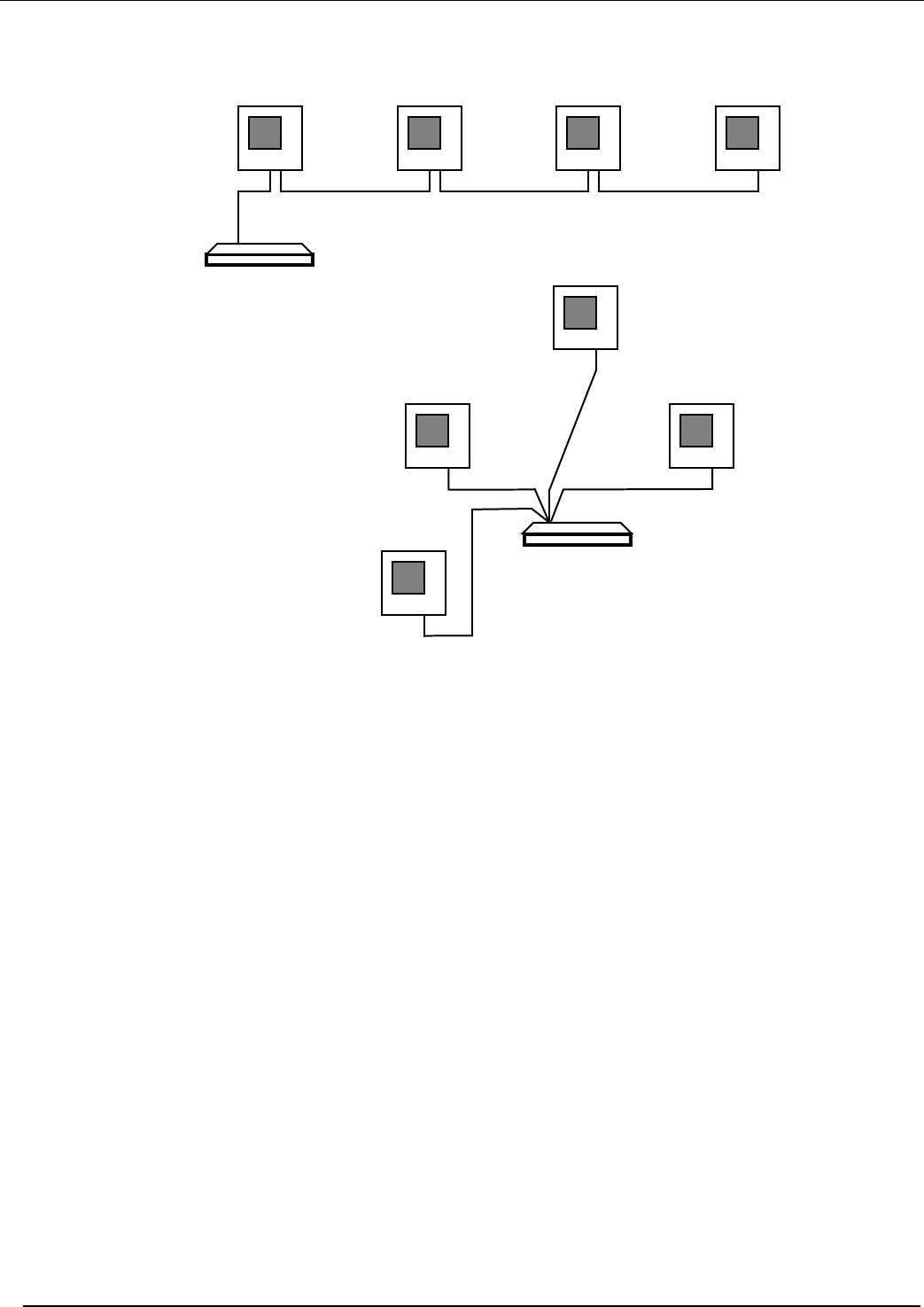
15162 Ver 2.8 DRAFT E Central Network Controller Installation Guide
Page 24 © 2002 Blick USA, Inc.
Note
A linear configuration is recommended but you can have up to four ‘spurs’. Each a maximum of
33ft/10m in length.
Linear
Star
CNC
CNC
Figure 6 Possible Six Wire Bus Wiring Configurations
4.10.2 Addresses
The six wire bus works by each door controller having its own unique address. It is good practice to
address door controllers consecutively.
However, on a site that communicates to the CNC via RS-232, the door controller connected to the
remote end of the RS-232 link must have address 1. The other door controllers will have addresses 2-8.
4.10.3 System Types/Controller Types
Door controllers can be configured in different ‘system types’ depending on the exact configuration they
are being used in. Only two of these types are used with the CNC:
System Type 2
The door controller connected directly to the remote end of an RS-232 communications link should be
configured as system type 2.
Up to 7 additional ‘slave’ (system type 3) controllers may then be connected to this controller via the six
wire bus.
System type 2 controllers are referred to throughout this document as ‘remote masters’.
There is no equivalent to this type of controller from the earlier PAC Portico 2000 Series. A PAC Portico
2000N controller can be connected to the remote end of an RS-232 communications link but no further
door controllers can then be added on this site via the six wire bus.
To summarize, master controllers may be:
• PAC Portico 2100 and PAC Portico 2200 Series Door Controllers (4-door) set to system type 2.
• PAC Portico 1100 and PAC Portico 1200 Door Controllers (2-door) set to system type 2.
System Type 3
Any door controllers that communicate to the CNC via the six wire bus, either directly to the CNC or via a

Central Network Controller Installation Guide 15162 Ver 2.8 DRAFT E
© 2002 Blick USA, Inc. Page 25
remote master should be configured as system type 3.
These controllers are referred to throughout this document as ‘slaves’ and may be considered equivalent
to the earlier PAC Portico 2000N controllers, which some installers may be aware of.
Therefore, slave controllers may be:
• PAC Portico 2100 and PAC Portico 2200 Series Door Controllers (4-door) set to system type 3.
• PAC Portico 1100 and PAC Portico 1200 Door Controllers (2-door) set to system type 3.
• PAC Portico 2000N MKI and MKII.
4.10.4 Direct Connect to CNC
Up to 32 slave door controllers, addressed 1 to 32, via ‘six wire bus’ port on CNC.
4.10.5 Direct RS-232 Link from CNC
One master door controller (configured as system type 2) and up to 7 slave door controllers, addressed 2,
3, 4, 5, 6, 7 and 8.
Note
You can have up to three such sites connected to the CNC.
4.10.6 Setting the Door Controller Address
See 15113 PAC Portico 2100/1100 Installation Guide or 15263 PAC Portico 2200/1200 Series Controllers
Installation Guide for details on how to set a door controller's address and system type.
4.10.7 Programming the System
Refer to 15172 PAC Portico for Windows System Configuration Guide, or 15964 Portico Prism
Operations Guide for details on programming the system.

15162 Ver 2.8 DRAFT E Central Network Controller Installation Guide
Page 26 © 2002 Blick USA, Inc.
5. Serial Communications
This type of communication uses the serial RS-232 outputs on the rear of the CNC to communicate with
door controllers.
There are two types of serial communication:
Direct Connection
A permanent connection to a door controller using line-drivers, leased line modems, pIPer Serial Ethernet
Units, etc. This type of connection is permanently on-line, events are reported as they happen and
updates are immediate. The user will not be aware of any difference between a directly connected serial
site and a six wire bus site. Up to three sites may be directly configured in this way to each CNC.
Dial-Up Connection Using PSTN Modems and LAN/WAN Communications Devices
The CNC can dial each site once or twice a day or at a programmable interval of between 10 minutes and
24 hours. On each occasion, transactions are received from the door controllers and updates are sent.
The door controller is also able to dial-back to the CNC when an alarm (2100 and 2200 Series
Controllers) or access authorized (2200 Series Controllers) events occurs. Up to 127 sites may be
connected in this way.
In addition, each site can be ‘force dialed’ via operator intervention from the administration software.
A single dial-up device connected to the CNC may dial different sites at different times of day. Up to three
dial-up devices may be connected to a single CNC.
Note
This section refers to dial-up devices; these may be modems or pIPer Serial Ethernet Units.
5.1 Direct Connection
There are three RS-232 serial ports fitted as standard to the CNC allowing up to three directly connected
sites. The maximum length of cable between the CNC and a door controller is 50ft/15m, to exceed this
distance you will need to use some type of line driver, leased line modem or other device.
There are several methods for directly connecting a CNC to a door controller over a distance greater than
50ft/15m:
• Line drivers or baseband modems.
• Fiber optic links.
• Radio data.
• Microwave.
• Extended distance RS-232 cable.
• TCP/IP.
Most serial communication devices will operate provided they satisfy the following specification:
• Asynchronous.
• Full duplex.
• Baud rate of 300, 1200, 2400, 4800, 9600.
• No parity, 8 data bits, 2 stop bits.
• Hardware/software flow control.

Central Network Controller Installation Guide 15162 Ver 2.8 DRAFT E
© 2002 Blick USA, Inc. Page 27
5.2 Dial-Up Communications
5.2.1 Description
By using dial-up devices, it is possible to communicate with more than 3 sites or with sites too distant to
be directly connected. Dial-up sites require the use of dial-up devices connected to standard public
(PSTN) telephone lines or LAN/WAN network.
From the administration software, remote sites are assigned to one of the three RS-232 ports on the
CNC. The CNC will dial up sites via the dial-up device connected to one of the RS-232 ports. A dial-up
device installed at each site, connected to the remote master door controller will answer the call.
Once communications are established, the CNC will receive transactions from the door controller and
send any database updates. A communications session will last as long as required for all transactions to
be received and all updates to be sent or until a programmable pre-set time limit expires.
5.2.2 Dial-Back
Normally events are only sent back to the central point at set times of the day when the CNC dials up the
site. This may be satisfactory for records of normal access events, however if an alarm occurs this would
not be reported until the next routine dial-up. A feature of the door controller allows it to 'dial-back' to the
CNC in the event of an alarm condition.
PAC
Portico
2200/
1200
Series
The current version PAC Portico 2200/1200 Series Door Controllers also allows the door controller to be
programmed so that in the event of an Access Authorized, Exit Authorized or Entry
Authorized transaction being generated the door controller will dial-back to the CNC. This powerful
facility may be configured on an individual door basis for each door controller on the site. For example, it
is possible to configure the master door controller so that it will dial-back in the event of access being
authorized through door one on each of door controllers 2, 3 and 4 on the site but not on any other doors.
This is in addition to dialing back in the event of any alarm occurring. Detailed information on
programming this feature is included in 15263 PAC Portico 2200/1200 Series Controllers Installation
Guide. The dial-back option can be set via the administration software.
The door controller stores one or two telephone numbers which it will use for the dial-back. A dial-up
device on the CNC will answer the call and connect to the door controller. Once the calling site has been
identified, all the high priority transactions will be sent from the site and only high priority commands will
be sent from the CNC to the site, allowing alarm acknowledgements to be sent back to the door
controllers. To ensure that a dial-back dial-up device is not tied up too long, the dial-back will be aborted
after 2 minutes of inactivity.
It is recommended that one dial-up device is used for routine dial-ups, and a second connected to another
CNC port, to be used for dial-back only. You could use the routine dial-up device as the backup dial-up,
i.e. the second phone number programmed into the door controller.
Note
When a dial-back occurs no low-priority transactions will be uploaded to the CNC and no ‘updates’
will be downloaded to the door controllers on the site.
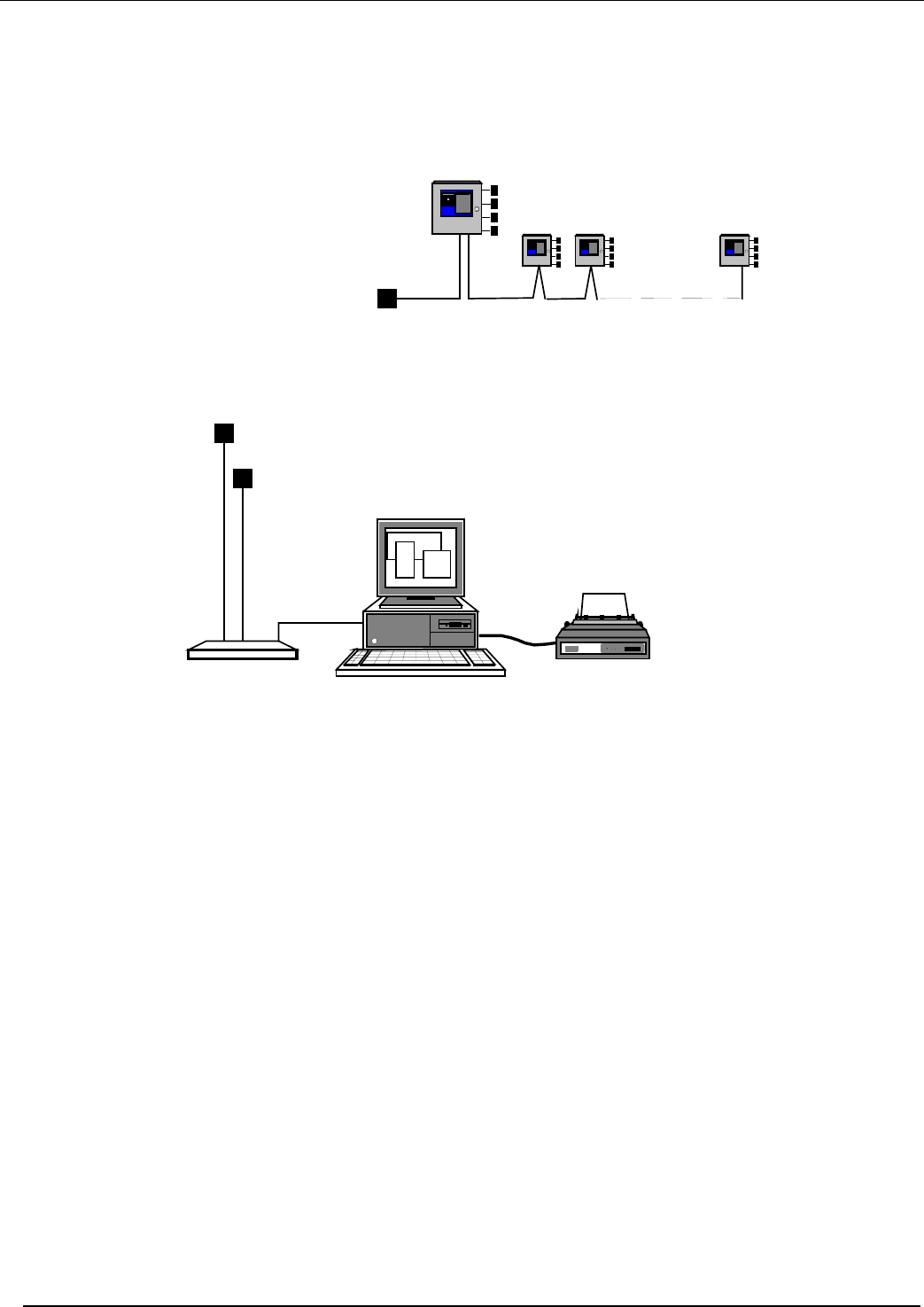
15162 Ver 2.8 DRAFT E Central Network Controller Installation Guide
Page 28 © 2002 Blick USA, Inc.
5.2.3 ‘Forget’ Transactions
A feature of the door controllers allows it to 'forget' (if programmed) certain groups of transactions such as
Request to Exit, Access Authorized, etc. This prevents these transactions from being sent and
therefore keeps communication times to a minimum.
Network Controller Parallel Printer
PC
Up to 7 Slave Door Controllers,
Six-Wire Bus
Master Door Controller
REMOTE SITE (Up to 127)
CENTRAL ADMINISTRATION POINT
Modem for Normal Dial Out
Optional Modem to Receive Dial-Back Only
Modem
Figure 7 CNC Using Dial-Back
5.2.4 Communication Protection
A feature of the door controller allows dial-up communications between a CNC and the door controller to
be protected. This is done by the CNC sending its supervisor keycode to the door controller, if this
compares with the door controller's supervisor keycode, communications will be established. If the codes
do not compare, the previous supervisor keycode stored in the CNC will be compared. If this also fails
comparison, the communications session will be aborted. Refer to 15113 PAC Portico 2100/1100
Installation Guide or 15263 PAC Portico 2200/1200 Series Controllers Installation Guide for full details.
Note
If this feature is in use, you should be careful not to change the supervisor keycode in the
administration system more than once without first dialing all the remote sites, to avoid ‘locking
yourself’ out of communications with a site.
5.2.5 Phone Lines
Each dial-up device you connect to the CNC will require its own phone line. If using the dial-back feature,
the phone number of the dial-back line is the number programmed into the door controller.
If you are using the dial-back feature, ensure that the number of the dial-up device at the CNC can be
reached directly - i.e. not through a switchboard and that the number does not have ‘incoming calls
barred’.
Each site will also require a phone line.

Central Network Controller Installation Guide 15162 Ver 2.8 DRAFT E
© 2002 Blick USA, Inc. Page 29
5.2.6 Network Communications
In order to communicate with remote controllers via a network, a specific network communication device
is required. This device is called a pIPer Serial Ethernet Unit. The same rules described in Section 5.2.5
apply for network communications. Instead of using a phone number these devices use IP addresses. For
more information, refer to the document 15407 pIPer Serial Ethernet Unit Installation and Configuration
Guide or call PAC Portico Technical Support.

15162 Ver 2.8 DRAFT E Central Network Controller Installation Guide
Page 30 © 2002 Blick USA, Inc.
6. Specification
6.1 Dimensions
All dimensions are in inches and millimeters (in/mm).
In both cases below at least 4in/100mm clearance should be allowed behind each unit for cables and
connectors.
CNC
Length x Width x Height 380 x 350 x 57
Power Supply Unit
Length x Width x Height 270 x 345 x 125
6.2 Power Requirements
Input Voltage 240V ac or 110V ac (different versions supplied)
Battery Output 13.8V dc at up to 370mA
Current Consumption CNC 12V dc @ 600mA
6.3 Fuses
The following table details the location, type and rating of each fuse.
Ref Location Type Rating
Mains Input Mains fuse under mains input connection HBC, anti-surge 250m
A
Ext Battery On back panel 20mm glass, anti-surge 3A
Int Battery On back panel 20mm glass, anti-surge 3A
6.4 Cables Supplied
Note
Drawings for all of these cables (except for the mains supply) are included in Appendix C - 21512
CNC MKI to MKII Upgrade Kit
6.5 Description
This kit allows you to upgrade an existing CNC-based installation to use the improved features and
performance of the new CNC, with the minimum of effort and time involved in performing the upgrade.
6.5.1 Contents of the Kit
The kit consists of a MKII CNC (the power supply is not supplied with this kit - the existing power supply
should be used) and four cables. These cables should be used to connect the cables that currently
connect to the host PC and RS-232 ports of the existing MKI CNC to the new MKII CNC.
Note
Do not attempt to use these cables to connect the MKII CNC directly to the host PC, modem, or
other RS-232 device - they will not work. They are ‘conversion’ cables.
6.6 Installation
46. Ensure the PC administration software is running and the CNC display is showing:
** MONITORING **
If any updates are displayed for sites, you should make sure they are sent to the door controllers on
those sites first - for sites that communicate via a dial-up modem, you may need to ‘force dial’ the site
first.
47. Make sure that all the connectors currently plugged into the rear of the CNC are labelled and easily
identified.

Central Network Controller Installation Guide 15162 Ver 2.8 DRAFT E
© 2002 Blick USA, Inc. Page 31
48. Make sure the On-Line Transaction display is visible and transactions are being displayed.
49. Disconnect the connectors from RS-232 ports 1 to 3 and the six wire bus on the rear of the CNC.
50. When no further transactions are being displayed by the PC administration software, log in to the PC
administration software using the supervisor key/card.
51. Disconnect the host PC and power supply connectors from the rear of the CNC.
52. Ensure the switches on the underside of the MKII CNC are correctly set, see Section 2.2.1. Particular
attention should be made to switch 7 - Host PC to CNC Baud Rate which is dependent on the
administration system being used.
53. Replace the MKI CNC with the MKII CNC.
54. Connect the cable from the power supply to the power supply connector on the MKII CNC. A
sequence of messages should be displayed - as described in Section 3.5.1.
55. Using one of the conversion cables supplied, connect the 9-way D-type connector to the host PC port
on the new CNC and the 25-way D-type connector to the existing CNC to PC cable.
Note
Do not attempt to use this cable to connect the new CNC directly to administration PC - it will not
communicate. It must be used in conjunction with the MKI CNC to PC cable.
56. Verify the PC to CNC communications status.
57. Initialise the CNC - this process will clear the contents of the CNC memory and send to the CNC
information about the sites being controlled.
58. Once the CNC has been initialised, you should reconnect the six wire bus cable from the door
controllers (as previously connected to the MKI CNC - no conversion cable is required). Confirm
communications are established to the door controllers, check the number of door controllers that are
being reported as communicating on the main transaction screen.
59. Next, you should reconnect any RS-232 sites using the remaining three conversion cables supplied
with the kit to connect the existing RS-232 leads to the RS-232 ports on the new CNC. These are used
in the same way as the host PC conversion cable - they cannot be used to directly connect the new
CNC directly to an RS-232 device, such as a modem.
IMPORTANT
Ensure that the correct RS-232 cables are connected to the correct RS-232 port on the CNC -
the PC administration software uses the RS-232 port number to help identify sites for
communication purposes.
60. Finally, confirm communications with all the RS-232 sites. For sites that communicate via a dial-up
modem, you will need to ‘force dial’ the site first.
6.7 Conversion Cables
Four MKI to MKII CNC conversion cables are supplied with this kit. The wiring of these cables is shown
below for information.
Supplied: Quantity 4, each 2 metres length.
Use 8-core 7/0.2mm2 cable, screened, maximum 6.6ft/2m length.
MKI CNC - Existing Cable MKII CNC Host PC/RS-232
25 pin female D-type connector 9 pin female D-type connector

15162 Ver 2.8 DRAFT E Central Network Controller Installation Guide
Page 32 © 2002 Blick USA, Inc.
(Screen) Case ———— Case (Screen)
1———— Case (Screen)
2———— 2
3———— 3
4———— 7
5———— 8
7———— 5
8———— 1
20 ———— 4
22 ———— 9
Appendix D - Cable Descriptions.
All the cables below are supplied by PAC Portico labeled and identified. However, a brief description is
included below for each cable.
6.7.1 Mains Supply
One mains lead is supplied with a molded plug and 5ft/1.5m of cable. A standard molded IEC socket
connects to the rear of the power supply unit.
6.7.2 Power Supply to CNC
One lead with 6.6ft/2m of cable is used to connect the power supply to the CNC. A male 9-pin D-type
connector fits to the power supply, a female 9-pin D-type connector fits to the CNC.
6.7.3 CNC to PC
Two cables are supplied, both 6.6ft/2m long with a female 9-pin connector at one end to connect to the
CNC host PC port. One cable has a female 9-pin D-type connector, the other a female 25-pin D-type
connector at the other end. You only need to use the cable that connects to the appropriate serial (COM:)
port on your PC.
6.7.4 Six Wire Bus
A short length of cable is supplied with a male 9-pin D-type connector at one end, the other end is flying
leads.

Central Network Controller Installation Guide 15162 Ver 2.8 DRAFT E
© 2002 Blick USA, Inc. Page 33
6.7.5 RS-232 Ports
Three RS-232 leads are supplied - to allow any RS-232 device to be connected (e.g. line drivers) to one
of the three RS-232 ports on the CNC. Each of these is 6.6ft/2m in length.
These are fitted with a 9-way female D-type for connecting to the CNC itself, and a 25-way male D-type
for connecting to the dial-up device or other RS-232 device. You should confirm with the installation
documentation of the RS-232 device that the connections match those expected by this cable. In the
event of the RS-232 device having different connection requirements, the 25-way connector may be
removed and the required connections made, using the color coding detailed in Appendix C - 21512 CNC
MKI to MKII Upgrade Kit
6.8 Description
This kit allows you to upgrade an existing CNC-based installation to use the improved features and
performance of the new CNC, with the minimum of effort and time involved in performing the upgrade.
6.8.1 Contents of the Kit
The kit consists of a MKII CNC (the power supply is not supplied with this kit - the existing power supply
should be used) and four cables. These cables should be used to connect the cables that currently
connect to the host PC and RS-232 ports of the existing MKI CNC to the new MKII CNC.
Note
Do not attempt to use these cables to connect the MKII CNC directly to the host PC, modem, or
other RS-232 device - they will not work. They are ‘conversion’ cables.
6.9 Installation
61. Ensure the PC administration software is running and the CNC display is showing:
** MONITORING **
If any updates are displayed for sites, you should make sure they are sent to the door controllers on
those sites first - for sites that communicate via a dial-up modem, you may need to ‘force dial’ the site
first.
62. Make sure that all the connectors currently plugged into the rear of the CNC are labelled and easily
identified.
63. Make sure the On-Line Transaction display is visible and transactions are being displayed.
64. Disconnect the connectors from RS-232 ports 1 to 3 and the six wire bus on the rear of the CNC.
65. When no further transactions are being displayed by the PC administration software, log in to the PC
administration software using the supervisor key/card.
66. Disconnect the host PC and power supply connectors from the rear of the CNC.
67. Ensure the switches on the underside of the MKII CNC are correctly set, see Section 2.2.1. Particular
attention should be made to switch 7 - Host PC to CNC Baud Rate which is dependent on the
administration system being used.
68. Replace the MKI CNC with the MKII CNC.
69. Connect the cable from the power supply to the power supply connector on the MKII CNC. A
sequence of messages should be displayed - as described in Section 3.5.1.
70. Using one of the conversion cables supplied, connect the 9-way D-type connector to the host PC port
on the new CNC and the 25-way D-type connector to the existing CNC to PC cable.
Note
Do not attempt to use this cable to connect the new CNC directly to administration PC - it will not
communicate. It must be used in conjunction with the MKI CNC to PC cable.
71. Verify the PC to CNC communications status.
72. Initialise the CNC - this process will clear the contents of the CNC memory and send to the CNC
information about the sites being controlled.
73. Once the CNC has been initialised, you should reconnect the six wire bus cable from the door
controllers (as previously connected to the MKI CNC - no conversion cable is required). Confirm

15162 Ver 2.8 DRAFT E Central Network Controller Installation Guide
Page 34 © 2002 Blick USA, Inc.
communications are established to the door controllers, check the number of door controllers that are
being reported as communicating on the main transaction screen.
74. Next, you should reconnect any RS-232 sites using the remaining three conversion cables supplied
with the kit to connect the existing RS-232 leads to the RS-232 ports on the new CNC. These are used
in the same way as the host PC conversion cable - they cannot be used to directly connect the new
CNC directly to an RS-232 device, such as a modem.
IMPORTANT
Ensure that the correct RS-232 cables are connected to the correct RS-232 port on the CNC -
the PC administration software uses the RS-232 port number to help identify sites for
communication purposes.
75. Finally, confirm communications with all the RS-232 sites. For sites that communicate via a dial-up
modem, you will need to ‘force dial’ the site first.
6.10 Conversion Cables
Four MKI to MKII CNC conversion cables are supplied with this kit. The wiring of these cables is shown
below for information.
Supplied: Quantity 4, each 2 metres length.
Use 8-core 7/0.2mm2 cable, screened, maximum 6.6ft/2m length.
MKI CNC - Existing Cable MKII CNC Host PC/RS-232
25 pin female D-type connector 9 pin female D-type connector
(Screen) Case ———— Case (Screen)
1———— Case (Screen)
2———— 2
3———— 3
4———— 7
5———— 8
7———— 5
8———— 1
20 ———— 4
22 ———— 9
Appendix D - Cable Descriptions.
6.10.1 External Reader
A 6.6ft/2m cable is supplied for connection of a PAC, KeyPAC, and/or Wiegand or Magstripe reader. This
is fitted with an 8-way DIN plug (male) at one end. The other end is flying leads - the color code for the
cable is given in Appendix C - 21512 CNC MKI to MKII Upgrade Kit
6.11 Description
This kit allows you to upgrade an existing CNC-based installation to use the improved features and
performance of the new CNC, with the minimum of effort and time involved in performing the upgrade.
6.11.1 Contents of the Kit
The kit consists of a MKII CNC (the power supply is not supplied with this kit - the existing power supply
should be used) and four cables. These cables should be used to connect the cables that currently
connect to the host PC and RS-232 ports of the existing MKI CNC to the new MKII CNC.
Note
Do not attempt to use these cables to connect the MKII CNC directly to the host PC, modem, or
other RS-232 device - they will not work. They are ‘conversion’ cables.
6.12 Installation
76. Ensure the PC administration software is running and the CNC display is showing:

Central Network Controller Installation Guide 15162 Ver 2.8 DRAFT E
© 2002 Blick USA, Inc. Page 35
** MONITORING **
If any updates are displayed for sites, you should make sure they are sent to the door controllers on
those sites first - for sites that communicate via a dial-up modem, you may need to ‘force dial’ the site
first.
77. Make sure that all the connectors currently plugged into the rear of the CNC are labelled and easily
identified.
78. Make sure the On-Line Transaction display is visible and transactions are being displayed.
79. Disconnect the connectors from RS-232 ports 1 to 3 and the six wire bus on the rear of the CNC.
80. When no further transactions are being displayed by the PC administration software, log in to the PC
administration software using the supervisor key/card.
81. Disconnect the host PC and power supply connectors from the rear of the CNC.
82. Ensure the switches on the underside of the MKII CNC are correctly set, see Section 2.2.1. Particular
attention should be made to switch 7 - Host PC to CNC Baud Rate which is dependent on the
administration system being used.
83. Replace the MKI CNC with the MKII CNC.
84. Connect the cable from the power supply to the power supply connector on the MKII CNC. A
sequence of messages should be displayed - as described in Section 3.5.1.
85. Using one of the conversion cables supplied, connect the 9-way D-type connector to the host PC port
on the new CNC and the 25-way D-type connector to the existing CNC to PC cable.
Note
Do not attempt to use this cable to connect the new CNC directly to administration PC - it will not
communicate. It must be used in conjunction with the MKI CNC to PC cable.
86. Verify the PC to CNC communications status.
87. Initialise the CNC - this process will clear the contents of the CNC memory and send to the CNC
information about the sites being controlled.
88. Once the CNC has been initialised, you should reconnect the six wire bus cable from the door
controllers (as previously connected to the MKI CNC - no conversion cable is required). Confirm
communications are established to the door controllers, check the number of door controllers that are
being reported as communicating on the main transaction screen.
89. Next, you should reconnect any RS-232 sites using the remaining three conversion cables supplied
with the kit to connect the existing RS-232 leads to the RS-232 ports on the new CNC. These are used
in the same way as the host PC conversion cable - they cannot be used to directly connect the new
CNC directly to an RS-232 device, such as a modem.
IMPORTANT
Ensure that the correct RS-232 cables are connected to the correct RS-232 port on the CNC -
the PC administration software uses the RS-232 port number to help identify sites for
communication purposes.
90. Finally, confirm communications with all the RS-232 sites. For sites that communicate via a dial-up
modem, you will need to ‘force dial’ the site first.
6.13 Conversion Cables
Four MKI to MKII CNC conversion cables are supplied with this kit. The wiring of these cables is shown
below for information.
Supplied: Quantity 4, each 2 metres length.
Use 8-core 7/0.2mm2 cable, screened, maximum 6.6ft/2m length.
MKI CNC - Existing Cable MKII CNC Host PC/RS-232
25 pin female D-type connector 9 pin female D-type connector

15162 Ver 2.8 DRAFT E Central Network Controller Installation Guide
Page 36 © 2002 Blick USA, Inc.
(Screen) Case ———— Case (Screen)
1———— Case (Screen)
2———— 2
3———— 3
4———— 7
5———— 8
7———— 5
8———— 1
20 ———— 4
22 ———— 9
Appendix D - Cable Descriptions.
6.14 Door Controller Software
Please note that when using a MKII CNC the software in the door controllers must be as follows:
6.14.1 PAC Portico 1100 and PAC Portico 2100
• Version 3.15 or later
6.14.2 PAC Portico 2200/1200 Series
• Version 1.08 or later.
Failure to ensure this could result in corrupt and incorrect transactions being reported and changes
made to the PC administration system not updating the information stored in the door controllers
correctly.
PAC Portico strongly recommends that to obtain maximum benefit from the improved features of the MKII
CNC, that all door controllers installed on the system are upgraded to PAC 1100, 2100 1200 or PAC 2200
Series Door Controllers with the firmware versions listed above.
6.15 Mean Time Between Failures
MTBF >100,000 hours

Central Network Controller Installation Guide 15162 Ver 2.8 DRAFT E
© 2002 Blick USA, Inc. Page 37
7. Appendix A - Full Download
7.1 Description
This appendix describes how to perform a full download to remote dial-up sites. The procedure in this
appendix must be used to ensure a successful download.
7.2 Download Procedure
Check that the CNC display shows MONITORING. If this is not the case, it is likely there are updates in
the CNC buffer waiting to be sent. If there are pending updates, each site must be dialed in order to clear
the CNC buffer prior to initiating a download to a remote site.
Note
The CNC will display a maximum of 8 sites that have updates pending.
Example
If 3 sites are currently on line and a total of 12 sites have updates waiting, the number of updates
for the 3 sites on-line and the 5 off-line sites with the highest number of updates will be displayed.
When you hang-up from a site that has completed receiving its updates, if there are more than 8
sites with updates, it is only now that you will see a new site appear in the CNC display.
A typical display when on-line to a site will look as follows:
SITE 33 *00037
This shows that site 33 is on-line (the asterisk * indicates on-line), with 37 updates remaining.
These updates will decrement as the controller receives them. An equals sign to the left of the
updates, e.g. = 00037 means the site is not on-line and there are 37 updates waiting.
Notes
1. If more than 5 off-line sites have equal updates, the 5 highest numbered sites will be displayed.
2. If the site is on a six wire bus arrangement or is connected using a direct RS-232 connection ,
updates will occur in real-time.
7.2.1 Initializing a CNC
There are certain situations (e.g. troubleshooting CNC problems) which may require the CNC to be
initialized. Initializing the CNC effectively clears out the update buffer, which means any sites that have
updates will be cleared. Each site that had updates will therefore need to be dialed and a full download
to the site will be required in order to get the previously cleared updates into the door controllers.
7.2.2 Initializing a Door Controller
Care should be taken prior to initializing a door controller. Initializing a door controller will erase its
database (e.g. all keyholders, door programming, access rights, etc). A download from the PC will be
required to get the door controller operational.

15162 Ver 2.8 DRAFT E Central Network Controller Installation Guide
Page 38 © 2002 Blick USA, Inc.
8. Appendix B - Non-PAC Portico Communication
Devices
This appendix describes various non-PAC Portico serial communication devices, including modems and
line drivers. pIPer Serial Ethernet Units can be used instead of modems, refer to the documentation
supplied with the pIPer units. For the most up-to-date information on recommended devices, please call
PAC Portico Technical Support.
8.1 Dial-Up Modems
Dial-up modems are usually described by the speeds at which they will operate. These are usually given
in the form of CCITT 'V' numbers - some examples are given below:
V21 300 baud
V22 1200 baud
V22bis 2400 baud
V32 9600 baud
V32bis 14400 baud
V34 28800 baud
Note
V22bis and faster dial-up devices will fall back to a slower speed if they encounter a bad line. As
PAC Portico equipment operates at a fixed baud rate, this will usually result in a communications
failure. The system will attempt to dial-up again and perhaps get a better quality line. This problem
can be overcome for most makes of dial-up device by programming using terminal emulation
software.
Under most circumstances a V32, 9600 baud, dial-up device should be suitable.
Usually the faster the dial-up device the more it costs, but it is on-line for a shorter period of time. For use
with PAC Portico equipment, you should select a dial-up device that gives the best price/performance. A
busy site with many transactions and updates will require a faster dial-up device, a quiet site not updated
very often will require a lower performance device.
The dial-up device at the CNC should always match the highest performance dial-up device on the
remote sites. For instance, you may have a 9600 baud dial-up device on a busy site and three 1200 baud
dial-up devices on three quieter sites. In this case, you should have a 9600 baud dial-up device at the
CNC. A dial-up device will usually support all speeds up to its own maximum.
Please consult PAC Portico Technical Support for the latest information on recommended dial-up devices
and other communications equipment.
8.2 Black Box Non-Powered Short Haul Modem - SHM-NPR
A pair of these devices will extend the distance that you can send the RS-232 signal from 50ft/15m to
12miles/20km, depending on the baud rate used (see Section 8.2.2). These devices should be used with
your own twisted-pair cable.
The devices may be used:
•Between the CNC and door controller.
•Between the CNC and a Black Box Code Operated Switch (COS).
•Between a Black Box COS and a door controller.
8.2.1 Description
These short haul modems are small devices that take their power from the RS-232 line itself. They allow
communications over distances between 0 and 12miles/20km depending on the speed of
communications.
Note
These devices are not suitable for connection to leased lines.
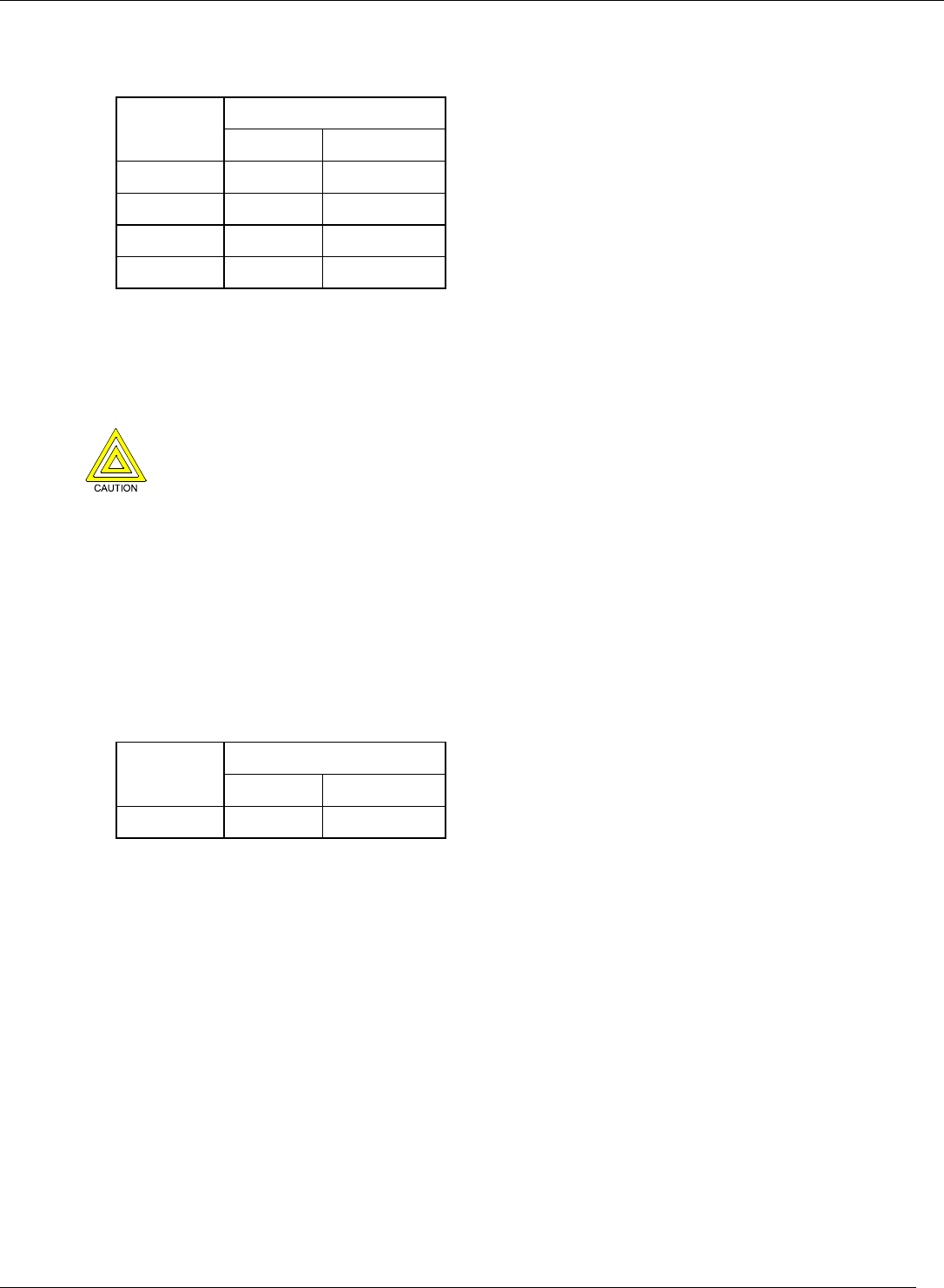
Central Network Controller Installation Guide 15162 Ver 2.8 DRAFT E
© 2002 Blick USA, Inc. Page 39
Each unit has a small switch labeled DCE/DTE on its side, this should be set to DCE.
These units are available with either a male or female 25-pin connector.
8.2.2 Distance
Maximum DistanceBaud Rate
miles km
9600 3 5
2400 4 7
1200 6 10
300 12 20
8.3 Black Box Line Driver - LD-120MP
A pair of these devices, also known as baseband modems, will extend the distance that you can send the
RS-232 signal from 50ft/15m to 5miles/8km. These devices are BABT approved for connecting to leased
lines or they may be used with your own twisted-pair cable.
Do not attempt to connect one of these devices to the public telephone system.
The devices may be used:
•Between the CNC and a door controller.
•Between the CNC and a Black Box COS.
•Between a Black Box COS and a door controller.
8.3.1 Description
These short haul modems are mains powered devices that allow communications over distances between
up to 5miles/8km at speeds up to 9600 baud.
8.3.2 Distance
Maximum DistanceBaud Rate
miles km
up to 9600 5 8
8.4 pIPer Serial Ethernet Units
The pIPer units are dial-up devices that can be used instead of modems. For more information, refer to
the document 17407 pIPer Serial Ethernet Unit Installation and Configuration Guide or call PAC Technical
Support.

15162 Ver 2.8 DRAFT E Central Network Controller Installation Guide
Page 40 © 2002 Blick USA, Inc.
9. Appendix C - 21512 CNC MKI to MKII Upgrade Kit
9.1 Description
This kit allows you to upgrade an existing CNC-based installation to use the improved features and
performance of the new CNC, with the minimum of effort and time involved in performing the upgrade.
9.1.1 Contents of the Kit
The kit consists of a MKII CNC (the power supply is not supplied with this kit - the existing power supply
should be used) and four cables. These cables should be used to connect the cables that currently
connect to the host PC and RS-232 ports of the existing MKI CNC to the new MKII CNC.
Note
Do not attempt to use these cables to connect the MKII CNC directly to the host PC, modem, or
other RS-232 device - they will not work. They are ‘conversion’ cables.
9.2 Installation
91. Ensure the PC administration software is running and the CNC display is showing:
** MONITORING **
If any updates are displayed for sites, you should make sure they are sent to the door controllers on
those sites first - for sites that communicate via a dial-up modem, you may need to ‘force dial’ the site
first.
92. Make sure that all the connectors currently plugged into the rear of the CNC are labelled and easily
identified.
93. Make sure the On-Line Transaction display is visible and transactions are being displayed.
94. Disconnect the connectors from RS-232 ports 1 to 3 and the six wire bus on the rear of the CNC.
95. When no further transactions are being displayed by the PC administration software, log in to the PC
administration software using the supervisor key/card.
96. Disconnect the host PC and power supply connectors from the rear of the CNC.
97. Ensure the switches on the underside of the MKII CNC are correctly set, see Section 2.2.1. Particular
attention should be made to switch 7 - Host PC to CNC Baud Rate which is dependent on the
administration system being used.
98. Replace the MKI CNC with the MKII CNC.
99. Connect the cable from the power supply to the power supply connector on the MKII CNC. A
sequence of messages should be displayed - as described in Section 3.5.1.
100. Using one of the conversion cables supplied, connect the 9-way D-type connector to the host PC port
on the new CNC and the 25-way D-type connector to the existing CNC to PC cable.
Note
Do not attempt to use this cable to connect the new CNC directly to administration PC - it will not
communicate. It must be used in conjunction with the MKI CNC to PC cable.
101. Verify the PC to CNC communications status.
102. Initialise the CNC - this process will clear the contents of the CNC memory and send to the CNC
information about the sites being controlled.
103. Once the CNC has been initialised, you should reconnect the six wire bus cable from the door
controllers (as previously connected to the MKI CNC - no conversion cable is required). Confirm
communications are established to the door controllers, check the number of door controllers that are
being reported as communicating on the main transaction screen.
104. Next, you should reconnect any RS-232 sites using the remaining three conversion cables supplied
with the kit to connect the existing RS-232 leads to the RS-232 ports on the new CNC. These are used
in the same way as the host PC conversion cable - they cannot be used to directly connect the new
CNC directly to an RS-232 device, such as a modem.

Central Network Controller Installation Guide 15162 Ver 2.8 DRAFT E
© 2002 Blick USA, Inc. Page 41
IMPORTANT
Ensure that the correct RS-232 cables are connected to the correct RS-232 port on the CNC -
the PC administration software uses the RS-232 port number to help identify sites for
communication purposes.
105. Finally, confirm communications with all the RS-232 sites. For sites that communicate via a dial-up
modem, you will need to ‘force dial’ the site first.
9.3 Conversion Cables
Four MKI to MKII CNC conversion cables are supplied with this kit. The wiring of these cables is shown
below for information.
Supplied: Quantity 4, each 2 metres length.
Use 8-core 7/0.2mm2 cable, screened, maximum 6.6ft/2m length.
MKI CNC - Existing Cable MKII CNC Host PC/RS-232
25 pin female D-type connector 9 pin female D-type connector
(Screen) Case ———— Case (Screen)
1———— Case (Screen)
2———— 2
3———— 3
4———— 7
5———— 8
7———— 5
8———— 1
20 ———— 4
22 ———— 9

15162 Ver 2.8 DRAFT E Central Network Controller Installation Guide
Page 42 © 2002 Blick USA, Inc.
10. Appendix D - Cable Descriptions
10.1 Power Supply
Supplied: Quantity 1, 6.6ft/2m length.
Use 10 core 7/0.2mm2 cable, maximum 6.6ft/2m length.
CNC, Power Supply Port Power Supply Unit
9 pin female D-type connector 9 pin male D-type connector
Relay 4 1 ———— 1 Relay 4
Relay 3 2 ———— 2 Relay 3
Relay 2 3 ———— 3 Relay 2
Relay 1 4 ———— 4 Relay 1
+13.8 V dc 5 ———— 5 +13.8 V dc
GND 6 ———— 6GND
GND 7 ———— 7GND
Relay Power 8 ———— 8 Relay Power
Ground 9 ———— 9 Ground
10.2 Host PC
Supplied: Quantity 2, each 6.6ft/2m length. One with 25-way D-type female, one with 9-way D-type
female at one end. Both have 9-way female D-type at other end.
Use 8 core 7/0.2mm2 screened cable, maximum 33ft/10m length.
10.2.1 9-way COM Port
CNC, Host PC Port PC
9 pin female D-type connector 9 pin female D-type connector
RX 2 ——<— 3TX
TX 3 ——>— 2RX
DTR 4 ——<— 8CTS
GND 5 ———— 5GND
DSR 6 ——<— 7RTS
RTS 7 ——>— 6DSR
CTS 8 ——<— 4DTR
(Screen) Case ———— Case (Screen)
10.2.2 25-way COM Port
CNC, Host PC Port PC
9 pin female D-type connector 25 pin female D-type connector
RX 2 ——<— 2TX
TX 3 ——>— 3RX
DTR 4 ——>— 5CTS
GND 5 ———— 7GND
DSR 6 ——<— 4RTS
RTS 7 ——<— 6DSR
CTS 8 ——>— 20 DTR
(Screen) Case ———— Case (Screen)
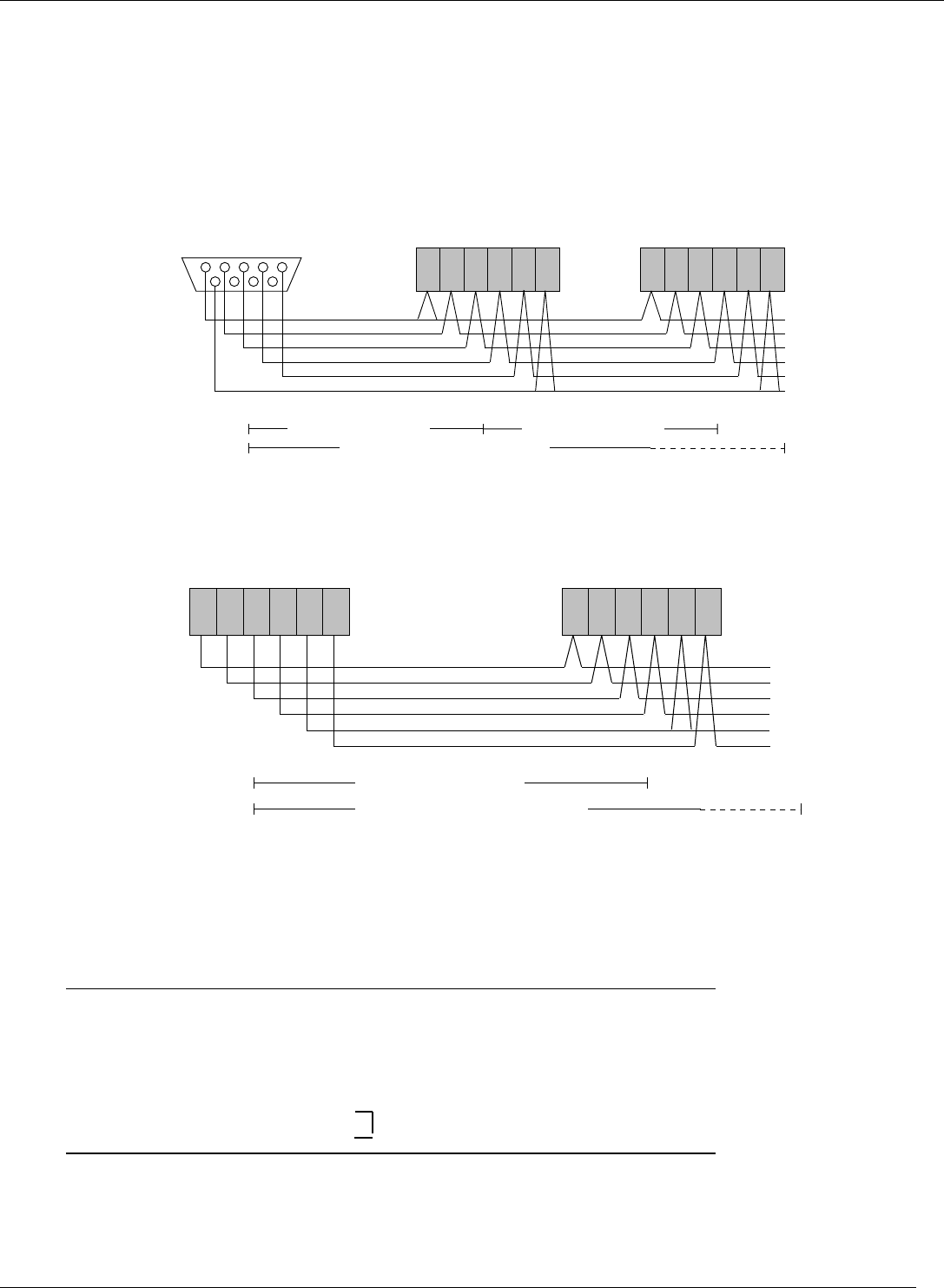
Central Network Controller Installation Guide 15162 Ver 2.8 DRAFT E
© 2002 Blick USA, Inc. Page 43
10.3 Six Wire Bus
Use multi-stranded, unscreened, 6-core, 22AWG/0.355mm² alarm or signal cable. If you do use screened
cable, you should reduce the maximum distance allowed by 3 times, i.e. to 1100ft/350m maximum.
Total amount of cable not to exceed 3000ft/1000m, and no single length more than 1500ft/500m.
10.3.1 CNC to Door Controller
Supplied: Quantity 1, flying lead - 6.6ft/2m length. Flying leads one end.
+V
AB1
AB2
USD
DSD
-V
Network Controller
Up to 32 Slave Door Controllers
+V AB1 AB2 DSD USD -V
SIX WIRE BUS
Slave Door Controller
Red
Yellow
White
Green
Blue
Black
1 2 3 4 5
6 7 8 9
Maximum Length: 500m
Maximum Total Bus Length: 1000
m
+V AB1 AB2 DSD USD -V
SIX WIRE BUS
Slave Door Controller
Maximum Length: 500m
Figure 8 CNC to Door Controller Wiring
10.3.2 Remote Site Master Door Controller to Slave Door Controller
+V AB1 AB2 DSD USD -V
SIX WIRE BUS
+V
AB1
AB2
USD
DSD
-V
+V AB1 AB2 DSD USD -V
SIX WIRE BUS
Master Door Controller Slave Door Controller
Up to 7 Slave Door Controllers
Red
Yellow
White
Green
Blue
Black
Maximum Length: 500m
Maximum Total Bus Length: 1000m
Figure 9 Remote Site Master to Slave Wiring
10.4 RS-232 Ports
10.4.1 Cable for Direct Connection to Door Controller
Use 4-core 24AWG/0.22mm² screened signal cable, maximum length: 50ft/15m.
CNC RS-232 Port 1, 2 or 3 Door Controller
9 pin female D-type connector 5-way terminal block
TX3 ———— TX
RX2 ———— RX
GND5 ———— GND
see Note DTR4
see Note CTS8
Note
The CTS signal should always be kept high at the CNC when a site is connected. The best way of
doing this is to connect the CTS signal (pin 8) to DTR (pin 4).

15162 Ver 2.8 DRAFT E Central Network Controller Installation Guide
Page 44 © 2002 Blick USA, Inc.
10.4.2 Cable for Connecting CNC to Modem
Use 8-core 24AWG/0.22mm² screened signal cable, maximum length: 50ft/15m.
Supplied: Quantity 3, each 6.6ft/2m length.
CNC, RS-232 Port 1, 2 or 3 Modem
9 pin female D-type connector 25 pin male D-type connector
Screen (Case) ———— (Case) Screen AND Pin 1
RX 2 ——<—— 3TX Red
TX 3 ——>—— 2RXBlue
DTR 4 ——>—— 20 DTR Orange
GND 5 ———— 7GNDBrown
DSR 6 ——>—— 6 DSR Yellow
RTS 7 ——>—— 4 RTS Green
CTS 8 ——<—— 5CTSBlack
see Note RI 9 ——<—— 22 RI White
Note
RI (pin 9) is only required if dial-back is being used.
10.4.3 Cable for Connecting Modem to Door Controller
Use 6-core 24AWG/0.22mm² screened signal cable, maximum length: 50ft/15m.
Modem Door Controller
25 pin male D-type connector 5-way terminal block
RX 2 ——<—— TX
TX 3 ——>—— RX
GND 7 ———— GND
CTS 5 ——>—— CTS
RTS 4 ———— DTR
DTR 20 ——<—— DTR
10.4.4 Short Haul Modems (SHM-NPR)
10.4.4.1 CNC to Short Haul Modem
Use 4-core 24AWG/0.22mm² screened signal cable, maximum length: 50ft/15m.
CNC RS-232 Port Short Haul Modem (DCE)
9 pin female D-type connector 25 pin male D-type connector
TX 3 —>—— 3RX
RX 2 —<—— 2TX
GND 5 ———— 7GND
CTS 8
see Note DTR 4 ——>— 20 DTR
Note
DTR at the short haul modem is used for providing power.

Central Network Controller Installation Guide 15162 Ver 2.8 DRAFT E
© 2002 Blick USA, Inc. Page 45
10.4.4.2 Short Haul Modem to Door Controller
Use 4-core 24AWG/0.22mm² screened signal cable, maximum length: 50ft/15m.
Short Haul Modem (DCE) Door Controller
25 pin male D-type connector 5-way terminal block
TX 2 —>—— RX
RX 3 —<—— TX
GND 7 ———— GND
see Note DTR 20 —<—— DTR
Note
DTR at the short haul modem is used for providing power.
10.4.4.3 Between Short Haul Modems
Use twin twisted pair, maximum length: speed dependent, see Section 8.2.2.
Short Haul Modem (DCE) Short Haul Modem (DCE)
screw terminals screw terminals
TXA ——>—— RXA
TXB ——>—— RXB
RXA ——<—— TXA
RXB ——<—— TXB
10.4.5 Connecting RDT to Door Controller
Use 4-core 24AWG/0.22mm² screened signal cable, maximum length: 50ft/15m.
RDT Door Controller
9 pin female D-type connector 5-way terminal block
TX 3 ——>—— RX
RX 2 ——<—— TX
GND 5 ———— GND
CTS 4 ———— DTR
10.5 External Reader
Supplied: Quantity 1, flying lead, 8 core screened, 6.6ft/2m length.
Refer to documentation supplied with reader for cable specifications.
CNC Pin Cable
Wire Color
PAC or
KeyPAC
Wiegand Magstripe
1 MAG DATA Yellow DATA
2 GND Black
3 WIEG D0 Green D0
4 MAG CLK Blue SIG CLK
5 WIEG D1 White D1
6 +5V Red
7+13.8V Brown +V +V +V
8 GND Orange -V/0V GND -V
Connector Case Cable
Screen
Cable
Screen
Cable
Screen
Notes
1. : Pins 6 and 7 (+5V and +13.8V dc) are rated at 200mA each.
2. The external reader port offers no LED/VCA support.

15162 Ver 2.8 DRAFT E Central Network Controller Installation Guide
Page 46 © 2002 Blick USA, Inc.
10.6 LD-120MP Line Drivers
10.6.1 CNC to LD-120MP
Use 4-core 24AWG/0.22mm² screened signal cable, maximum length: 50ft/15m.
CNC RS-232 Port LD-120MP
9 pin male D-type connector 25 pin male D-type connector
RX 3 ——<— 3TX
TX 2 ——>— 2RX
GND 5 ———— 7GND
CTS 8
see Note DTR 4
Note
The CTS signal should always be kept high at the CNC when a site is connected. This should be
done by connecting the CTS signal (pin 8) to DTR (pin 4).
10.6.2 LD-120MP to Door Controller
Use 4-core 24AWG/0.22mm² screened signal cable, maximum length: 50ft/15m.
LD-120MP Door Controller
25 pin male D-type connector 5-way terminal block
RX 2 —<—— TX
TX 3 —>—— RX
GND 7 ———— GND
10.6.3 Between LD-120MPs
Use twin twisted pair, maximum length: speed dependent, see Section 8.3.2.
LD-120MP LD-120MP
screw terminals screw terminals
1———— 4
2———— 3
3———— 2
4———— 1

Central Network Controller Installation Guide 15162 Ver 2.8 DRAFT E
© 2002 Blick USA, Inc. Page 47
11. Appendix E - COS-4/8 Data Switches
An alternative arrangement to using the six wire bus at a remote site is to use a Black Box Code Operated
Switch (COS). This device, available in 4-port or 8-port versions, switches control between the CNC and
up to 4 or 8 door controllers. Each door controller should be configured as a slave, system type 3.
The COS may be connected directly to the CNC, or via a dial-up modem. Connections from the COS to
the door controllers may use line drivers or other directly communicating devices, see Section 5.1.
Note
It is not possible to use dial-back when using a COS.
This configuration is only used where it is not practical to run a new cable for the six wire bus between
door controllers on a site or where the distances involved exceed those permitted by the six wire bus.
Note
If the first door controller on a site is a PAC Portico 2000N and it is required to add further door
controllers to the site, it is recommended that this is upgraded to a PAC Portico 2100 (via upgrade
kit, part number 21720) instead of using a COS, wherever practical. A PAC Portico 2100 with a
local six wire bus to additional slave controllers will give a greatly enhanced performance over
using a COS.
Connecting and Configuring the COS
The COS is a complex piece of communications equipment - the design and specification of which varies
from time to time.
For this reason, you should contact PAC Portico Technical Support for information regarding wiring and
configuration of the COS if you intend to use one. The relevant information will be made available to you
once the exact COS specification has been established.

15162 Ver 2.8 DRAFT E Central Network Controller Installation Guide
Page 48 © 2002 Blick USA, Inc.
This page is intentionally left blank.